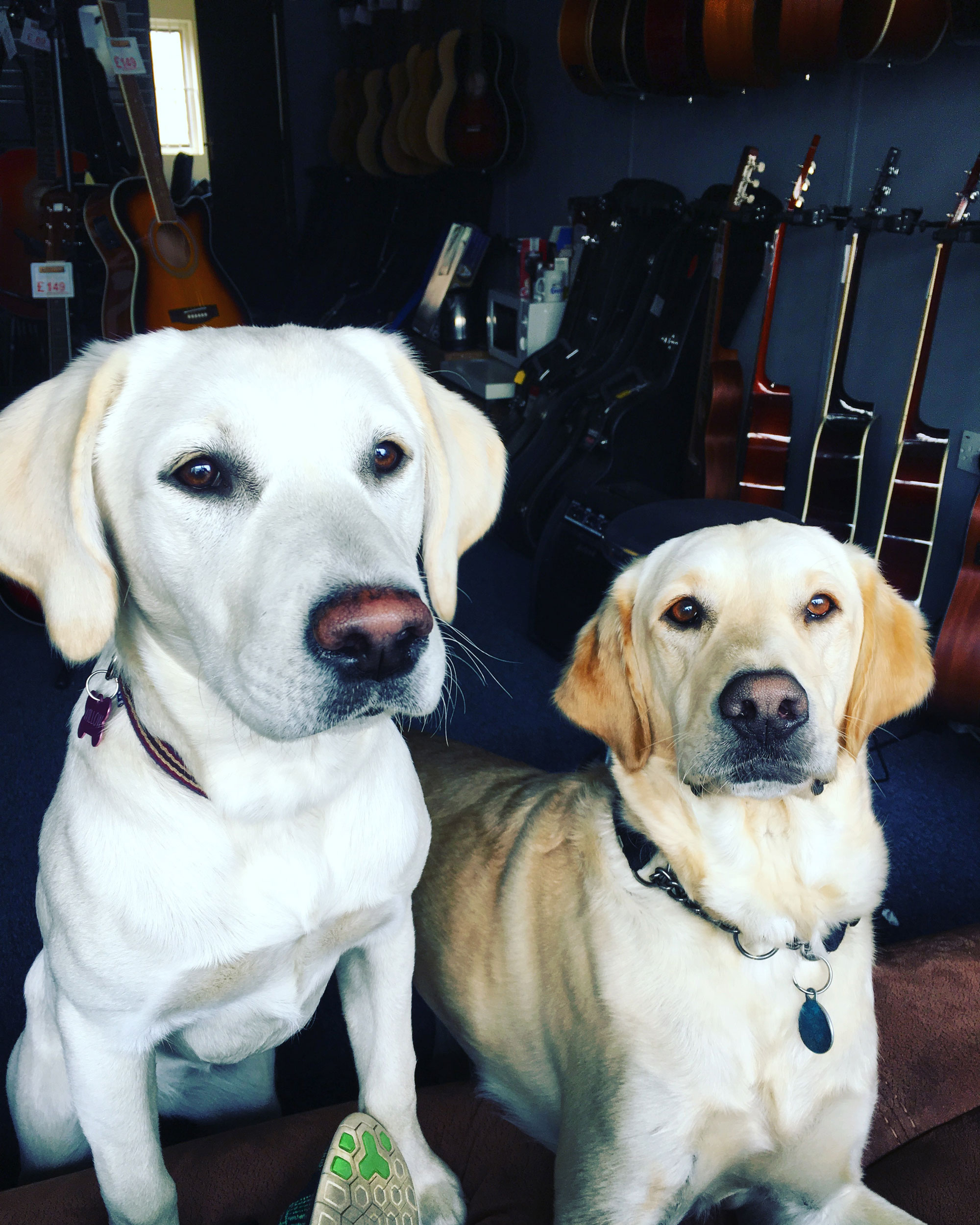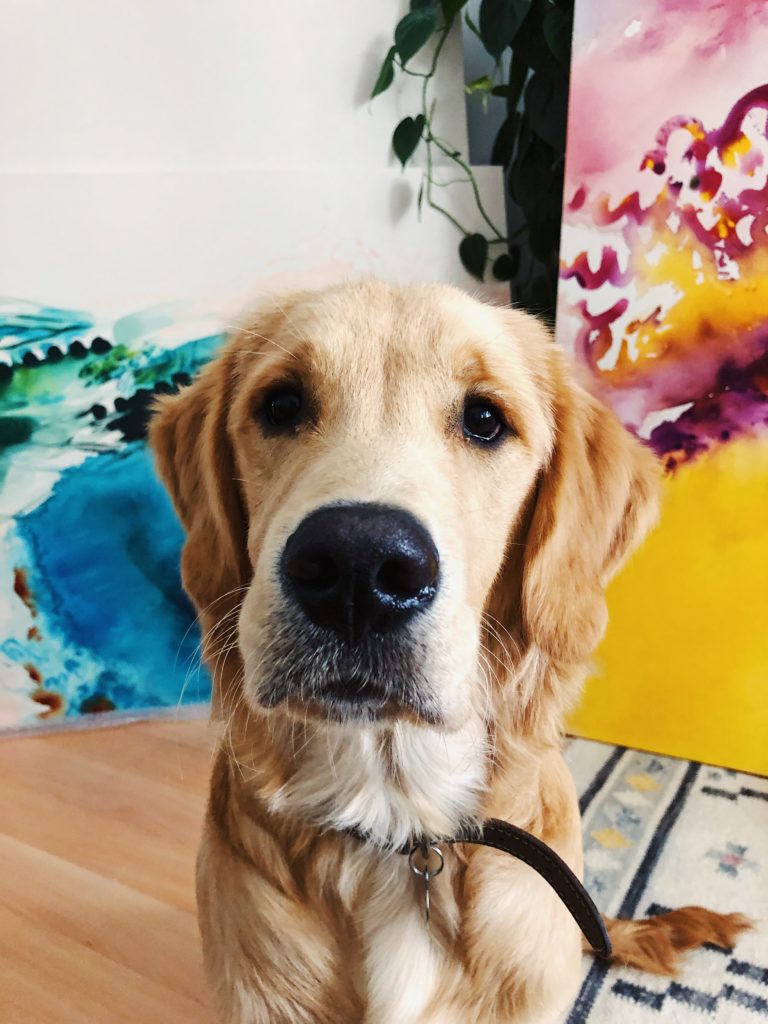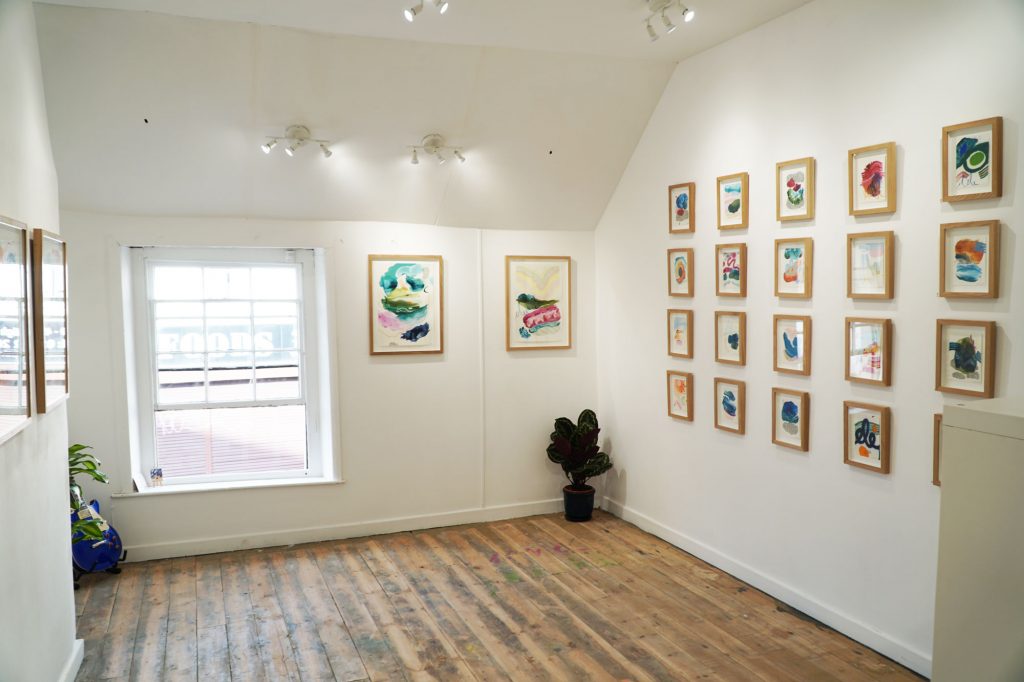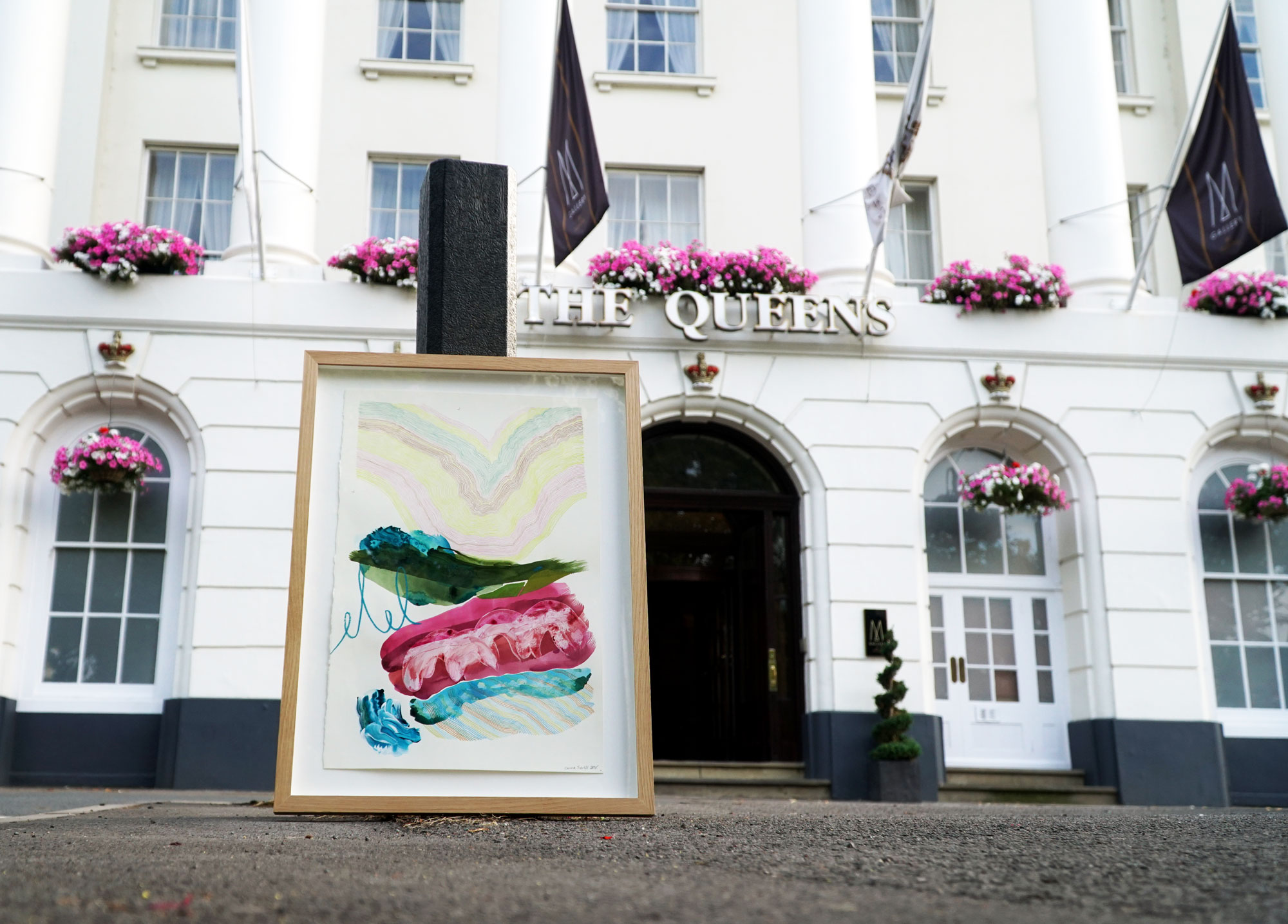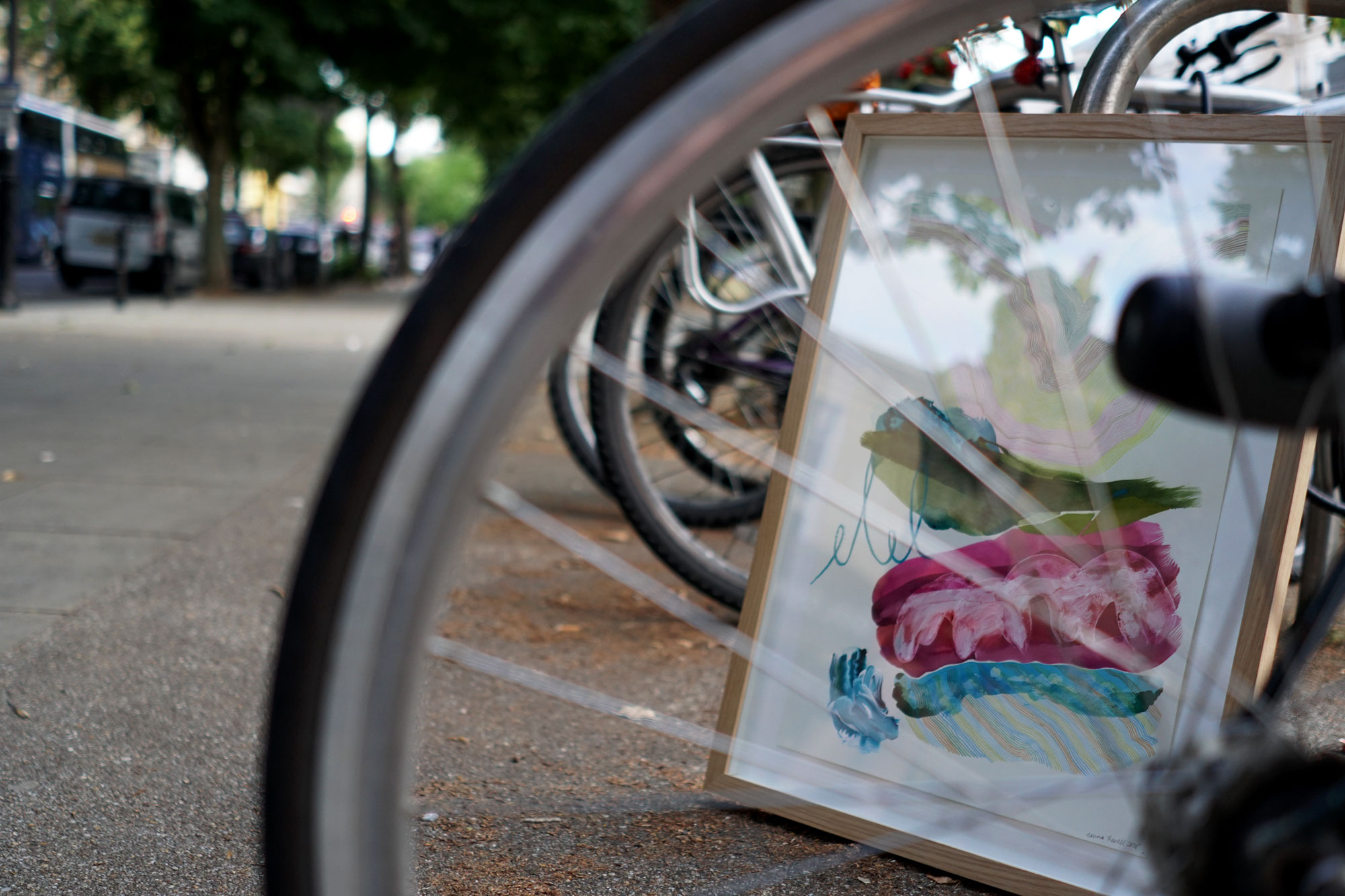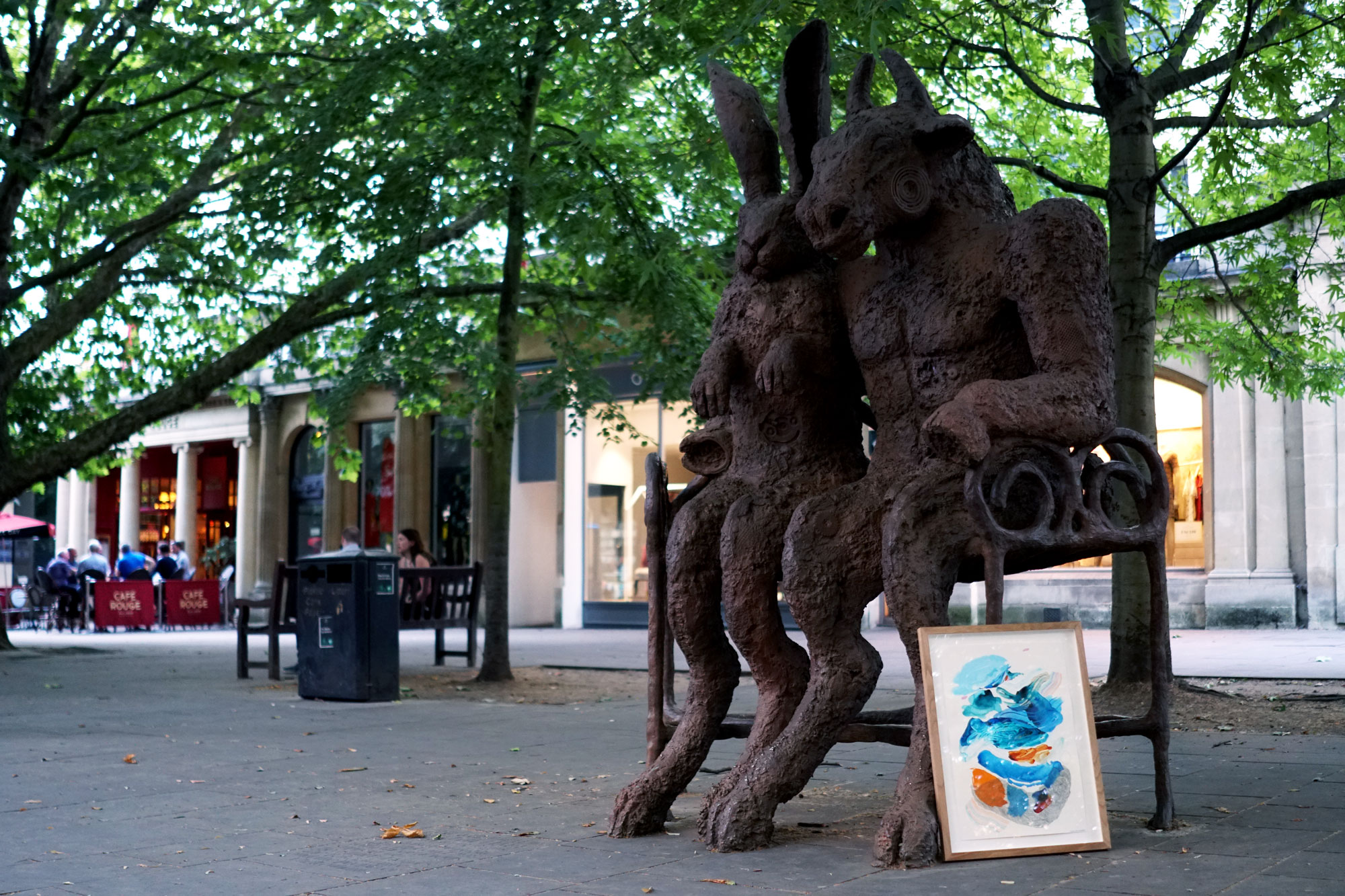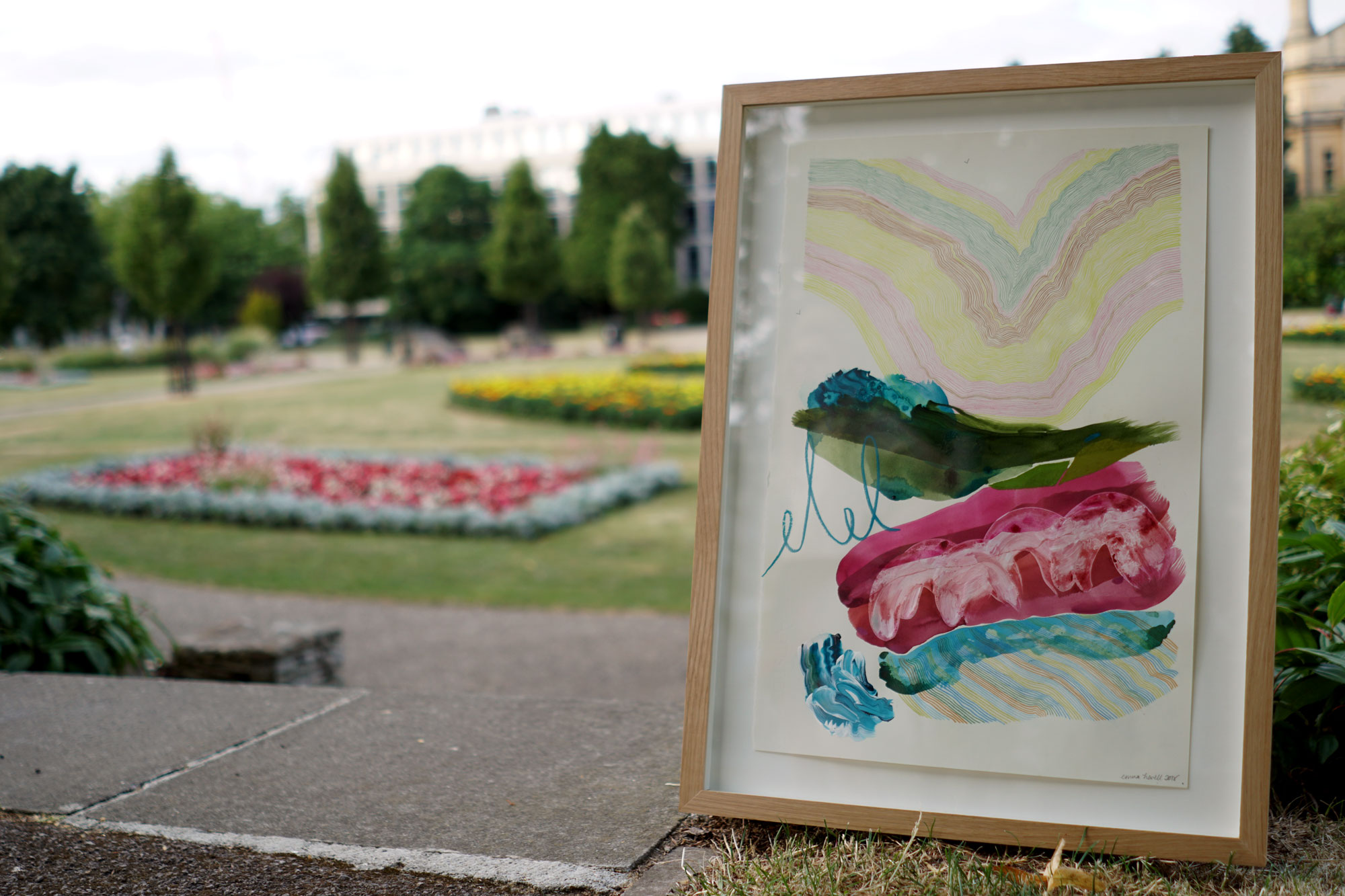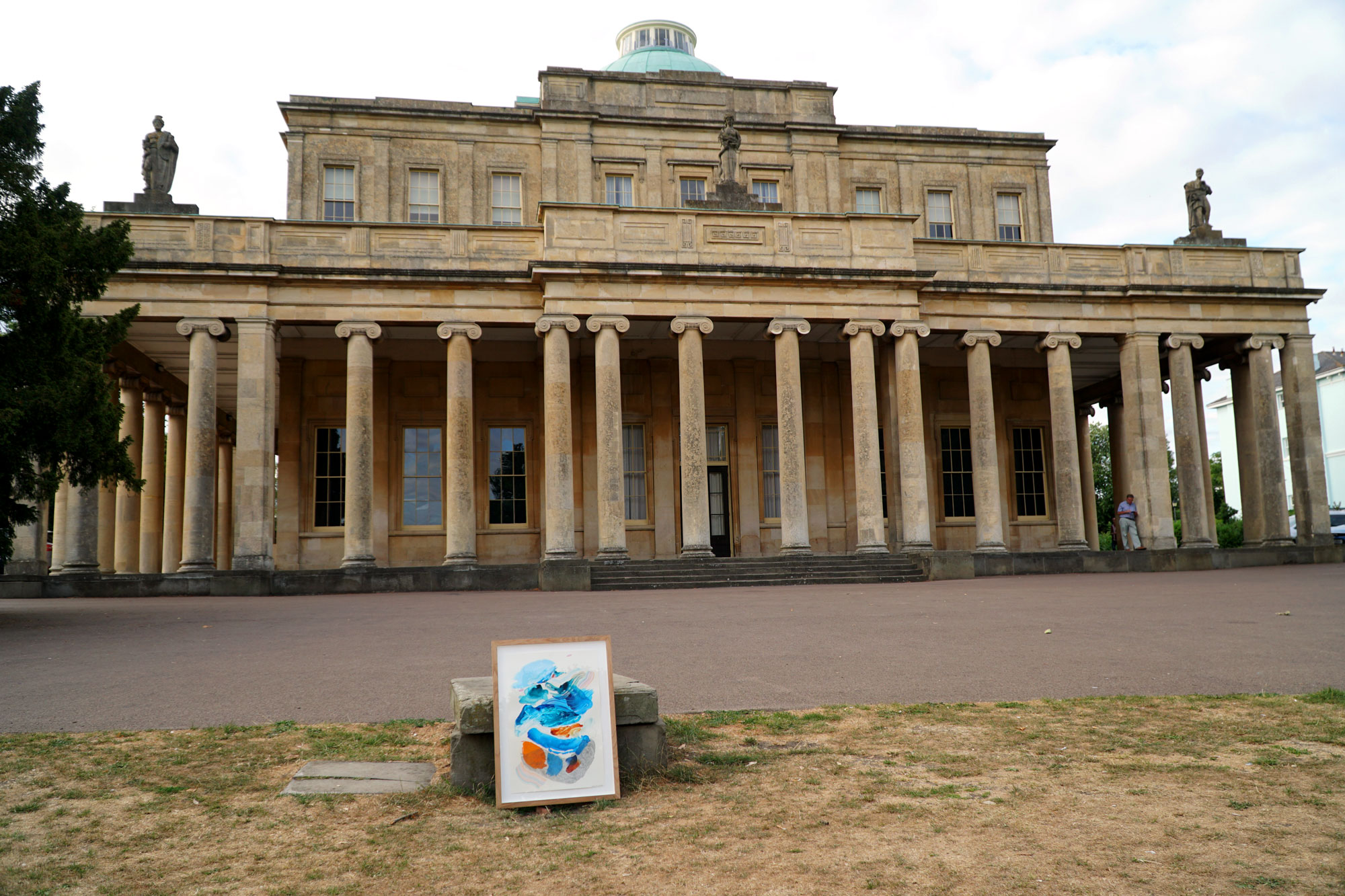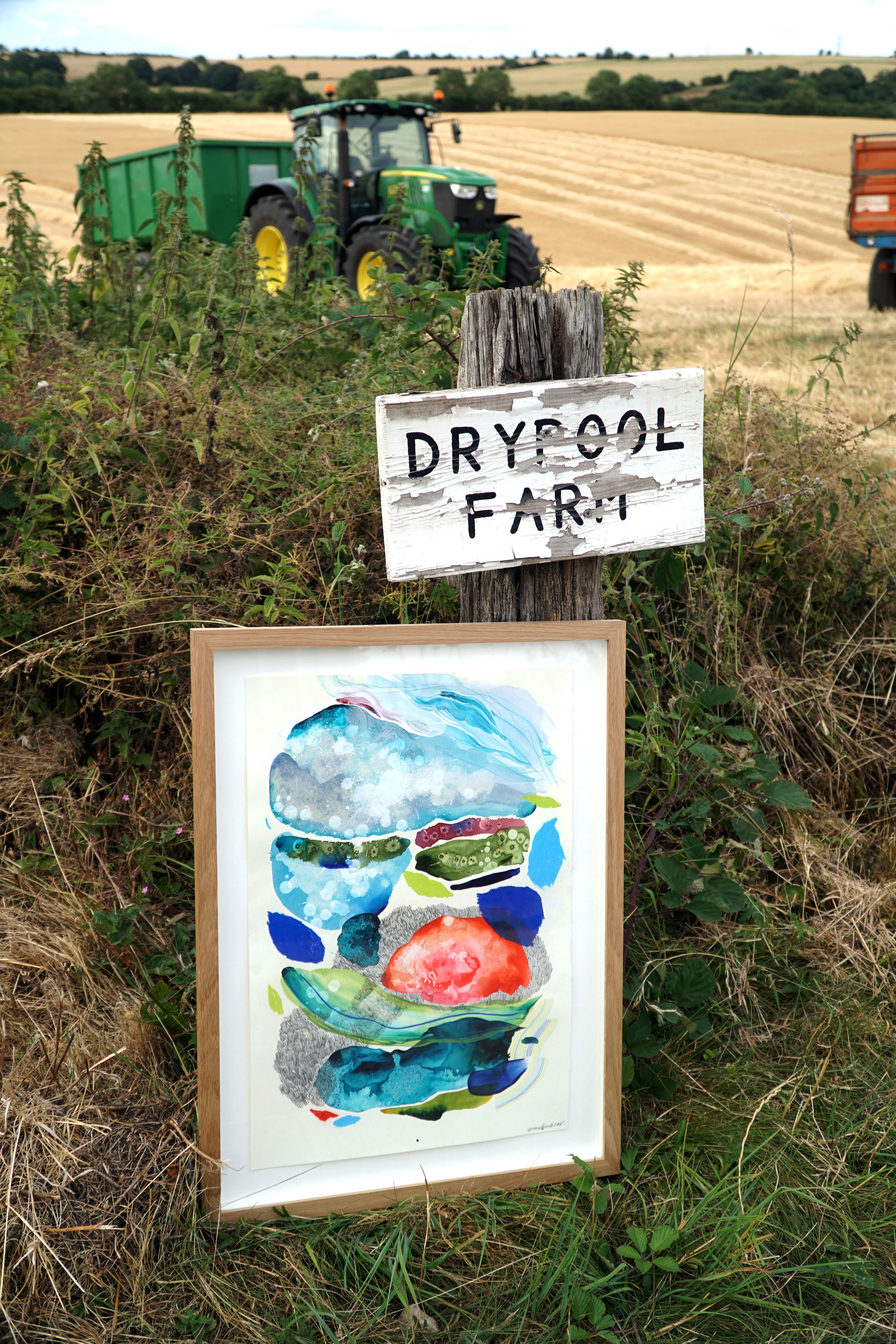Category:
Soul Testaments: The Chair Collection
June 30th, 2024 by Emma
“Soul Testaments: The Chair Collection” is a series of 15 individual paintings, each featuring a solitary chair set against a variety of environments.
Each chair stands as a testament to what it is to be human, capturing moments of quiet introspection and the silent stories of those who once occupied them (or who will occupy them). A chair that sits alone can be seen as a silent witness to the passage of time, a sanctuary from life’s chaos, a marker of personal space and individuality, or an image of waiting, hoping, and enduring.
“Soul Testaments” invites the viewer to see beyond the surface, encouraging a deeper reflection on the essence of human existence. The empty chairs may signify loss or absence, yet they also offer a sense of resilience and permanence amidst changing surroundings. They stand as symbols of endurance, capturing the quiet strength found in moments of stillness and the profound stories that emerge from silence.
This collection is not just a visual journey but an emotional one, inviting each viewer to find their own connection with the solitary chairs and to ponder the subtle yet powerful narratives they convey. Through this body of work, we are reminded of the enduring nature of the human spirit, the personal spaces we create, and the unspoken testament of our lives etched into the simple form of a chair.
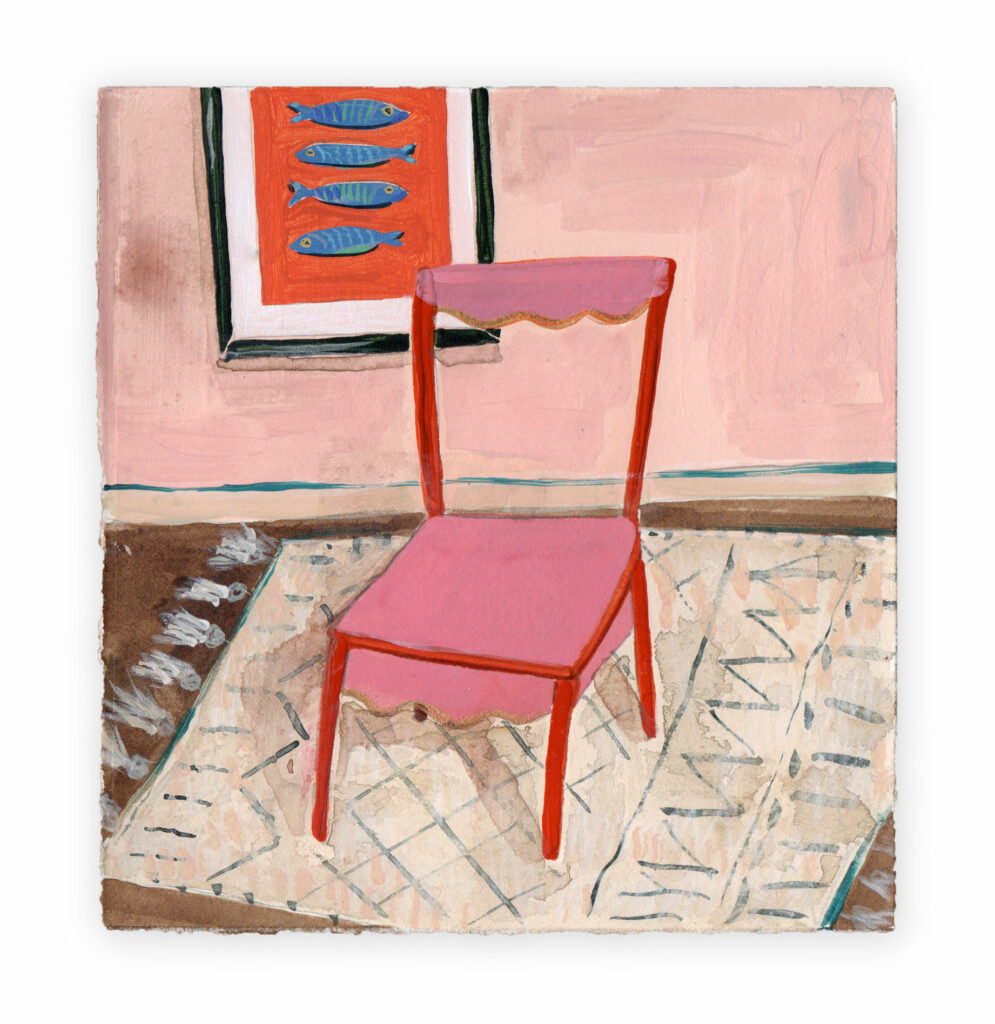
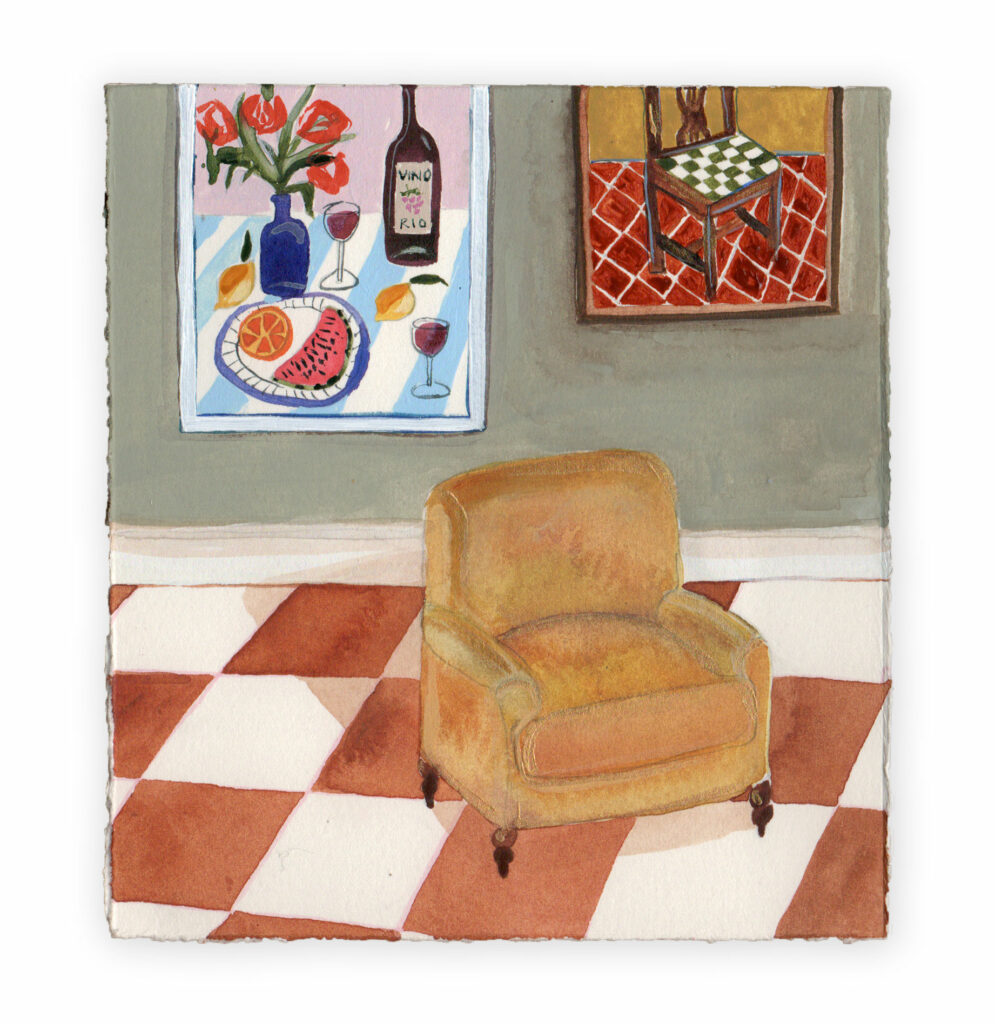
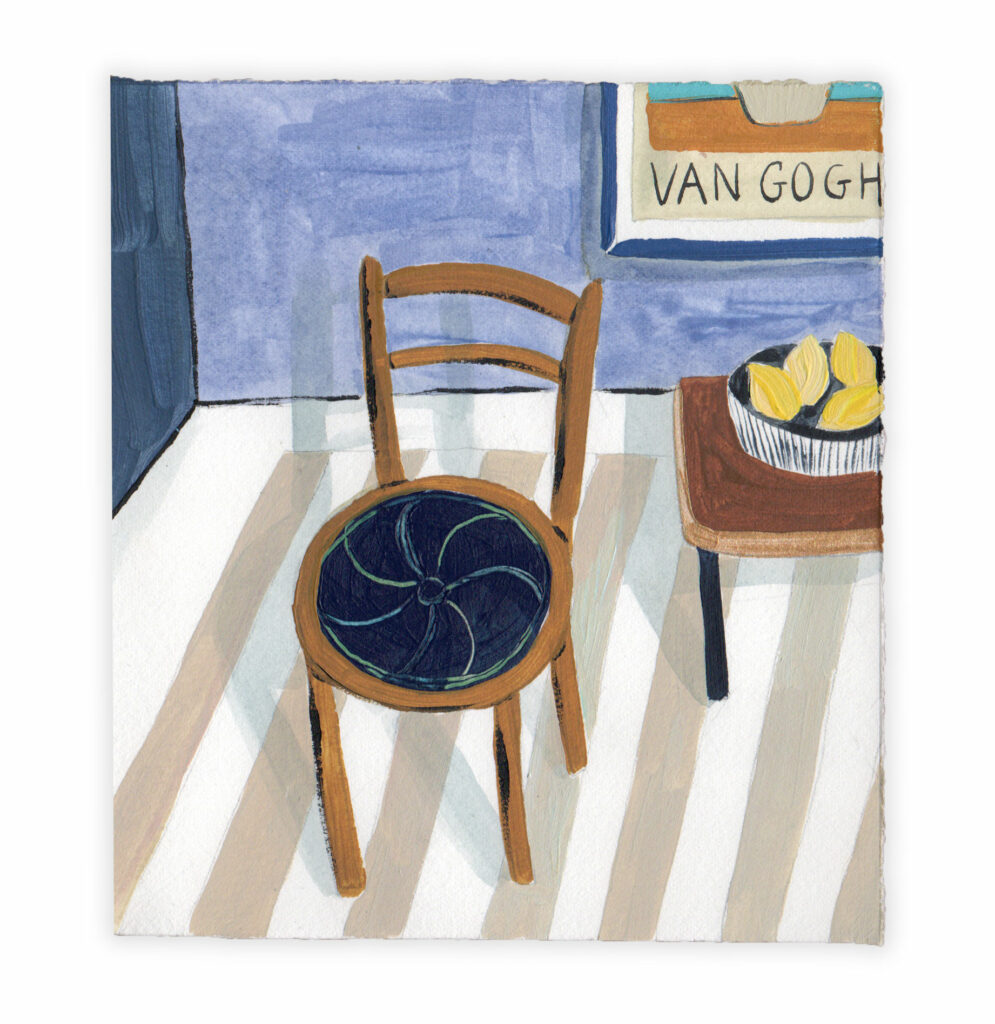
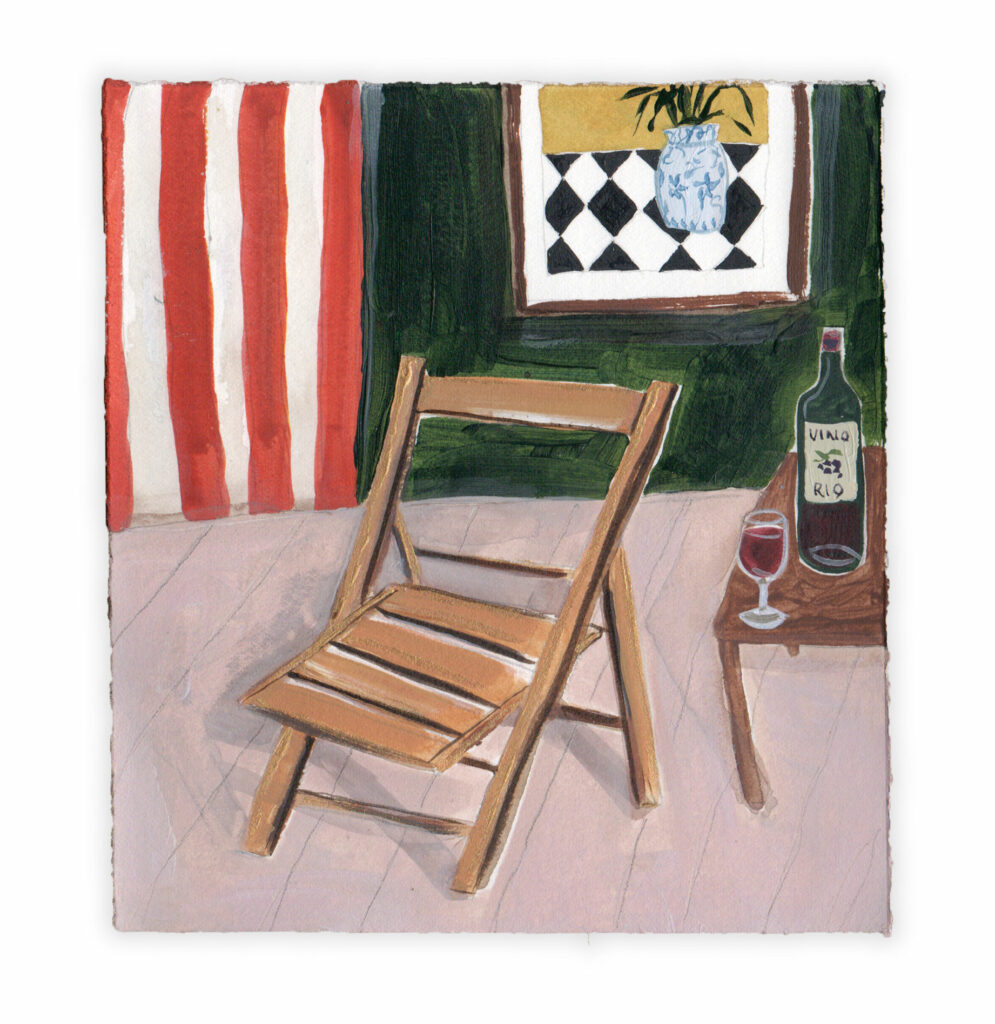
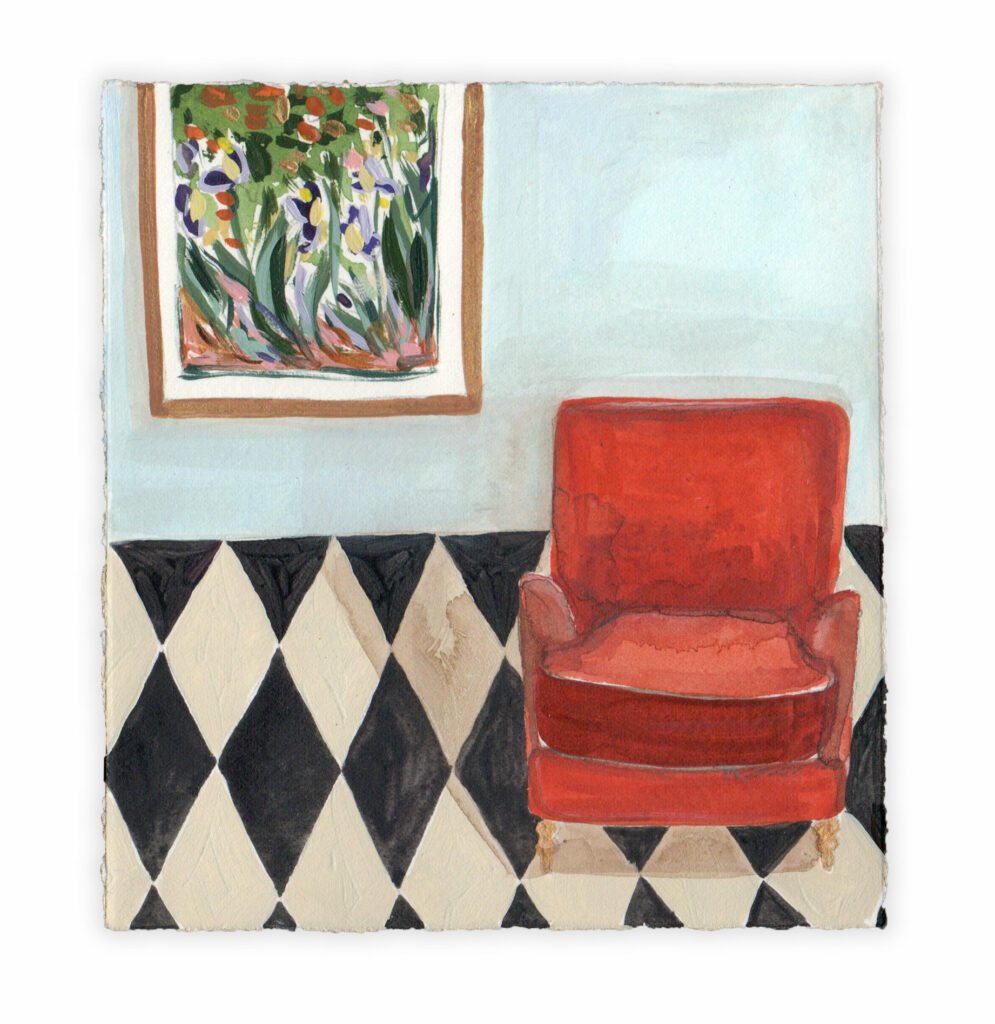
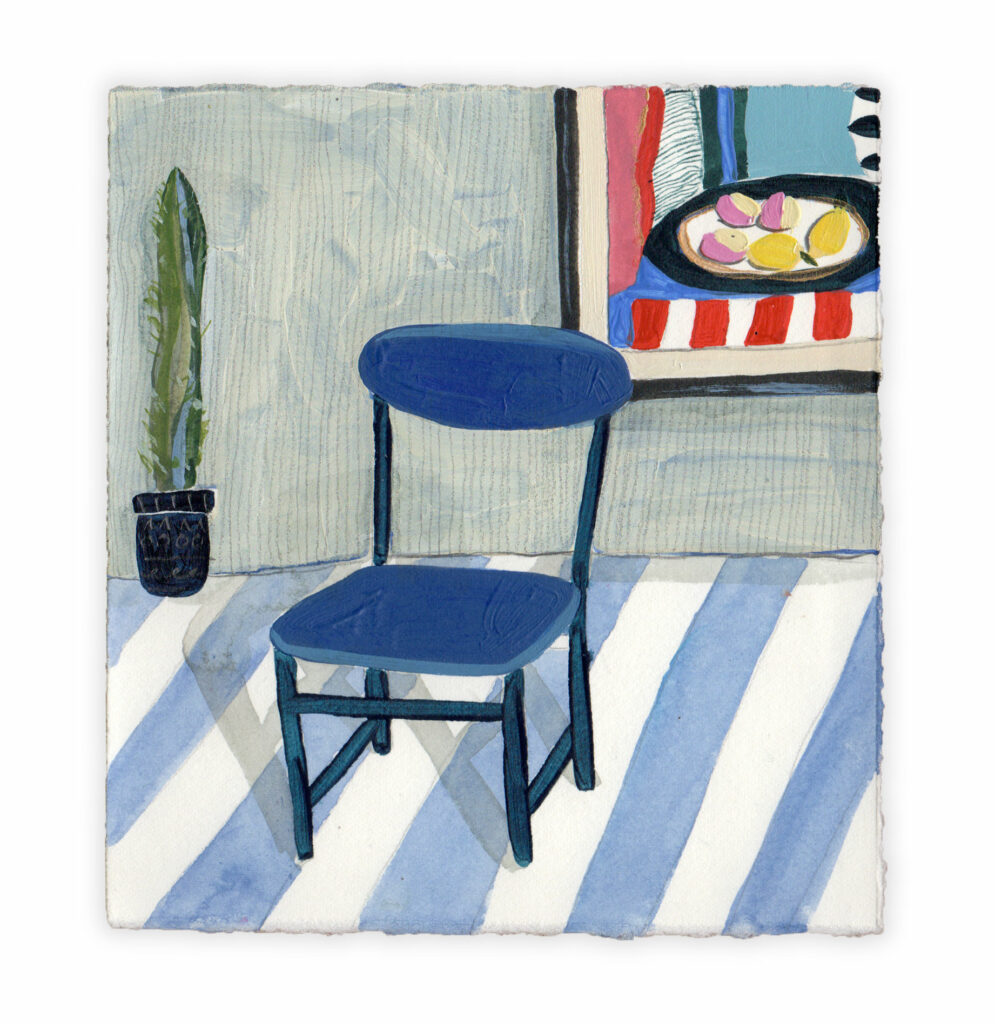
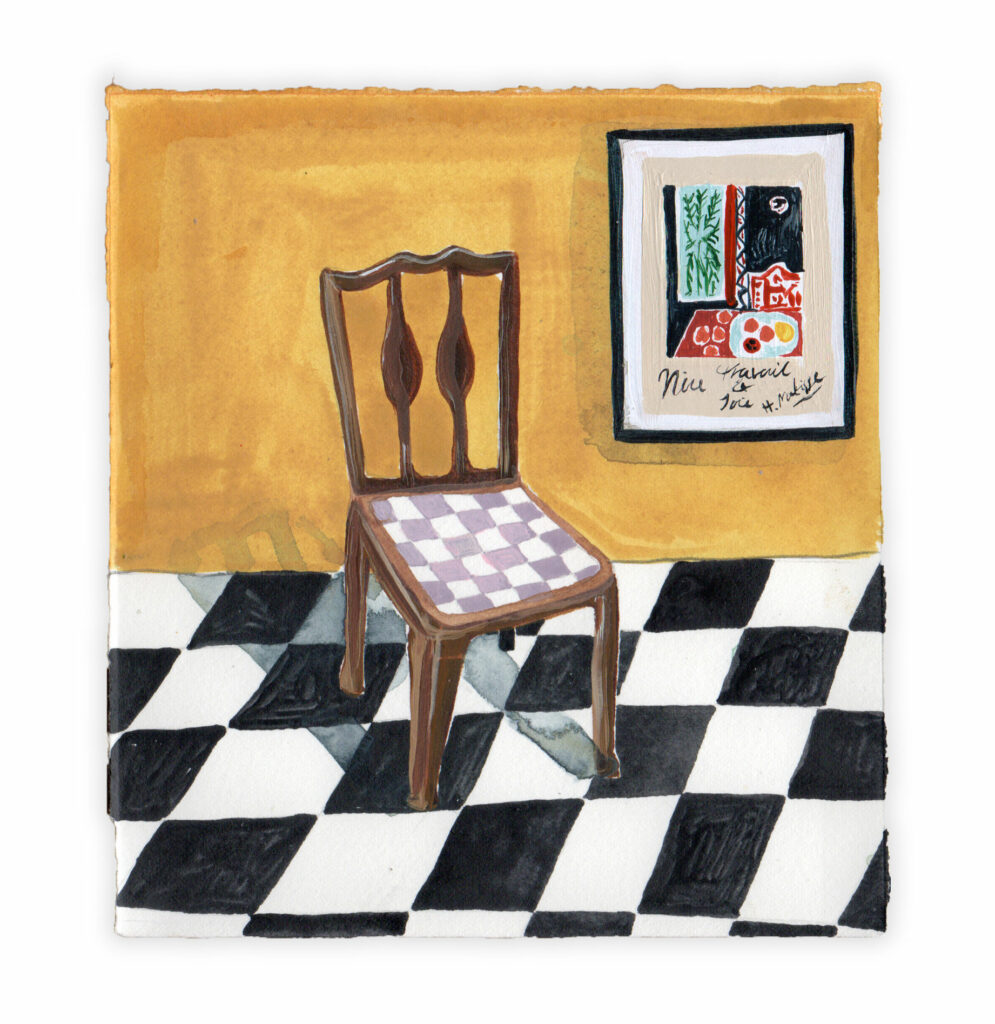
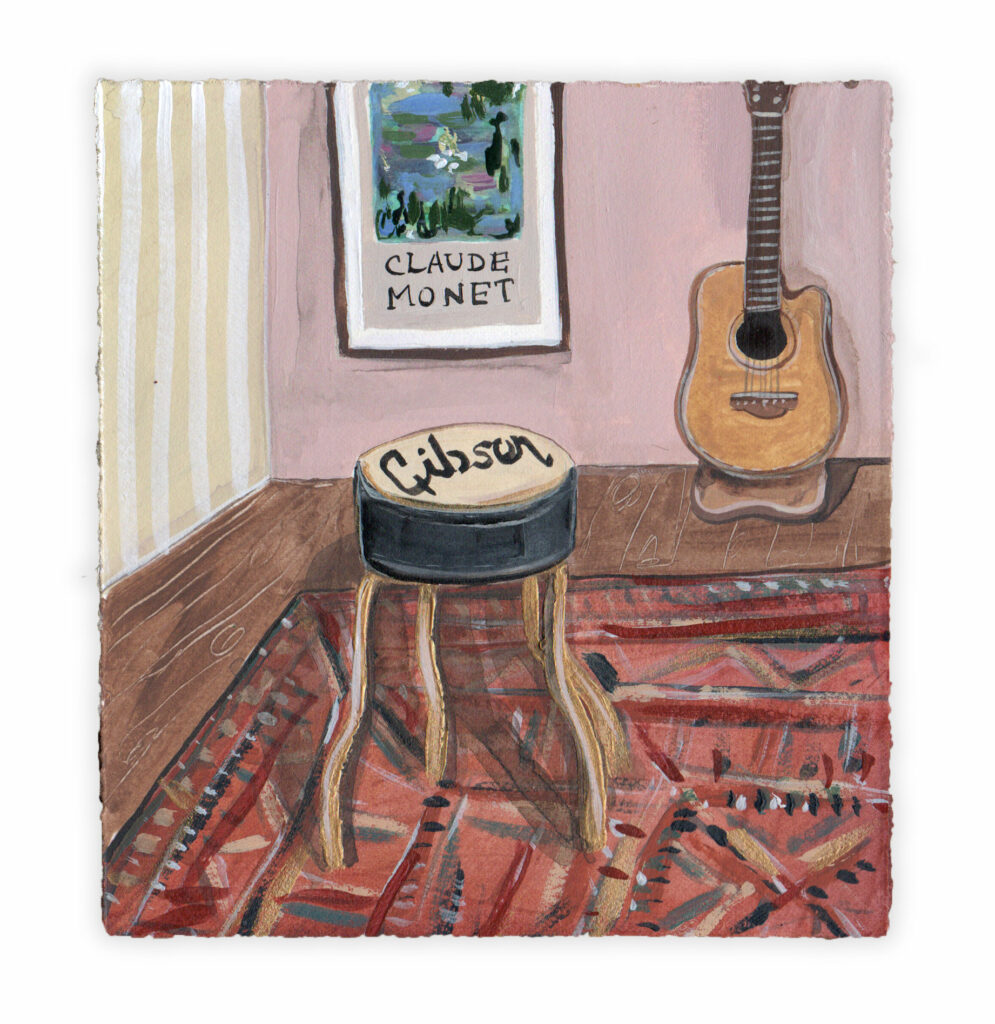
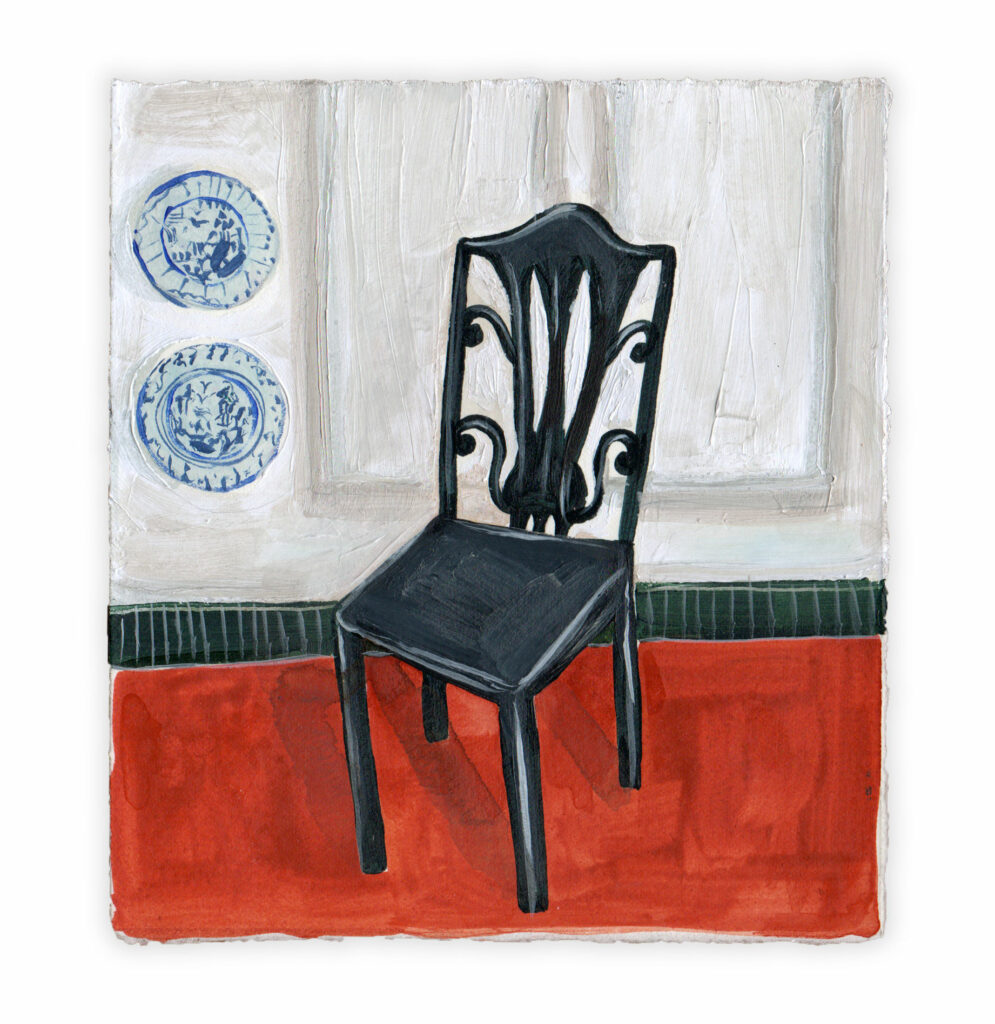
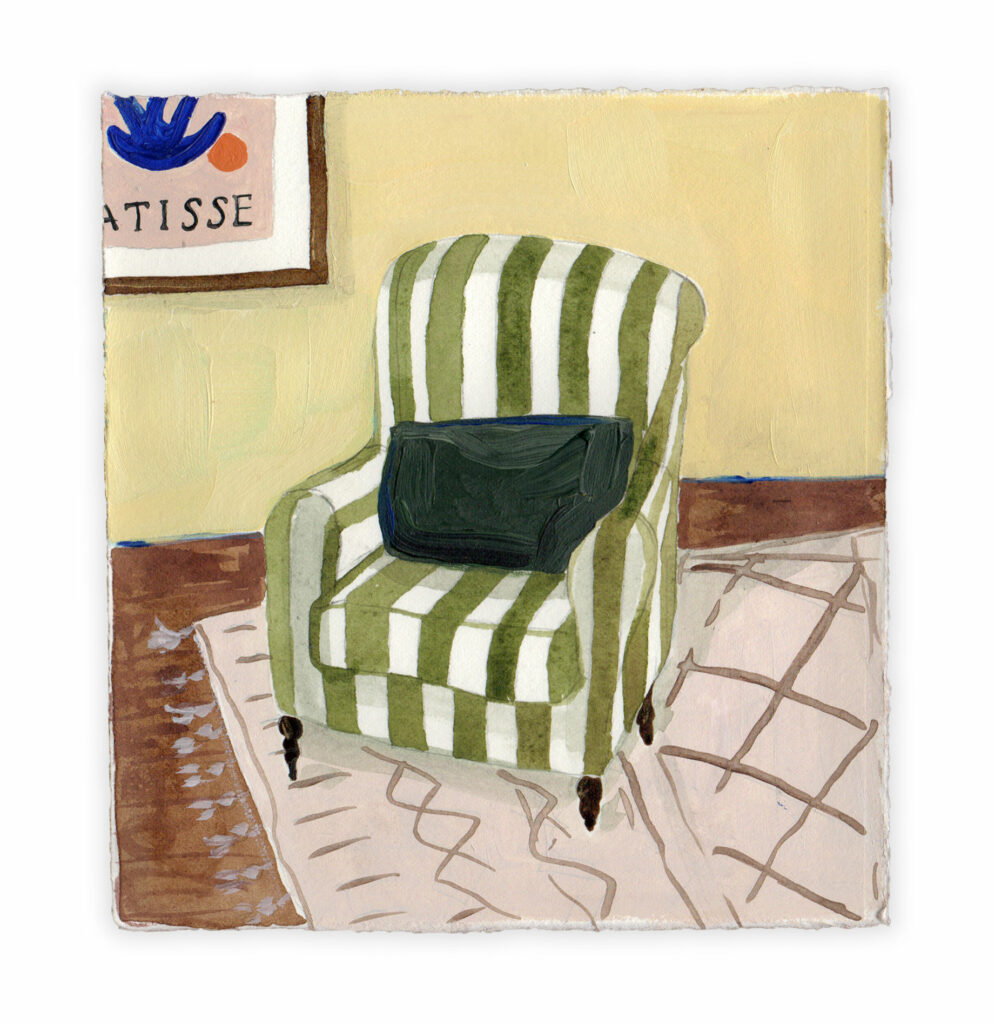
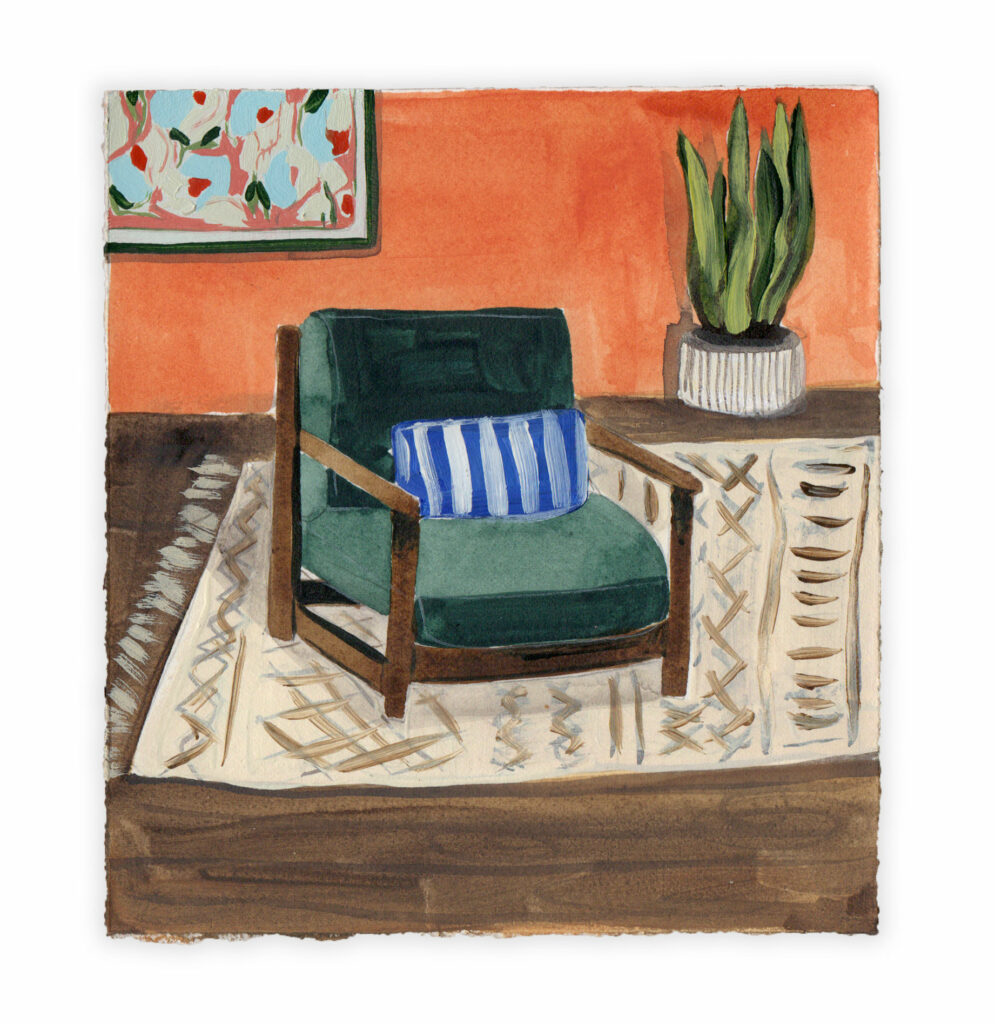
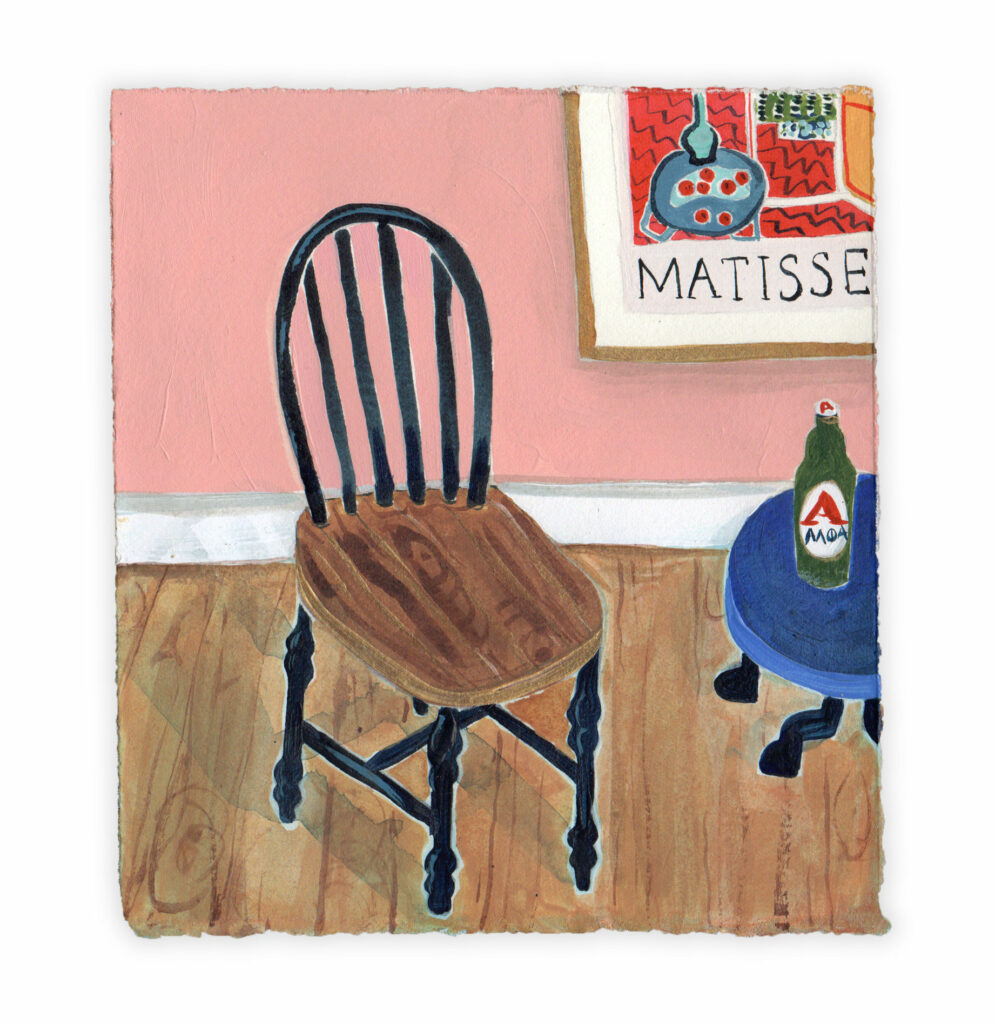
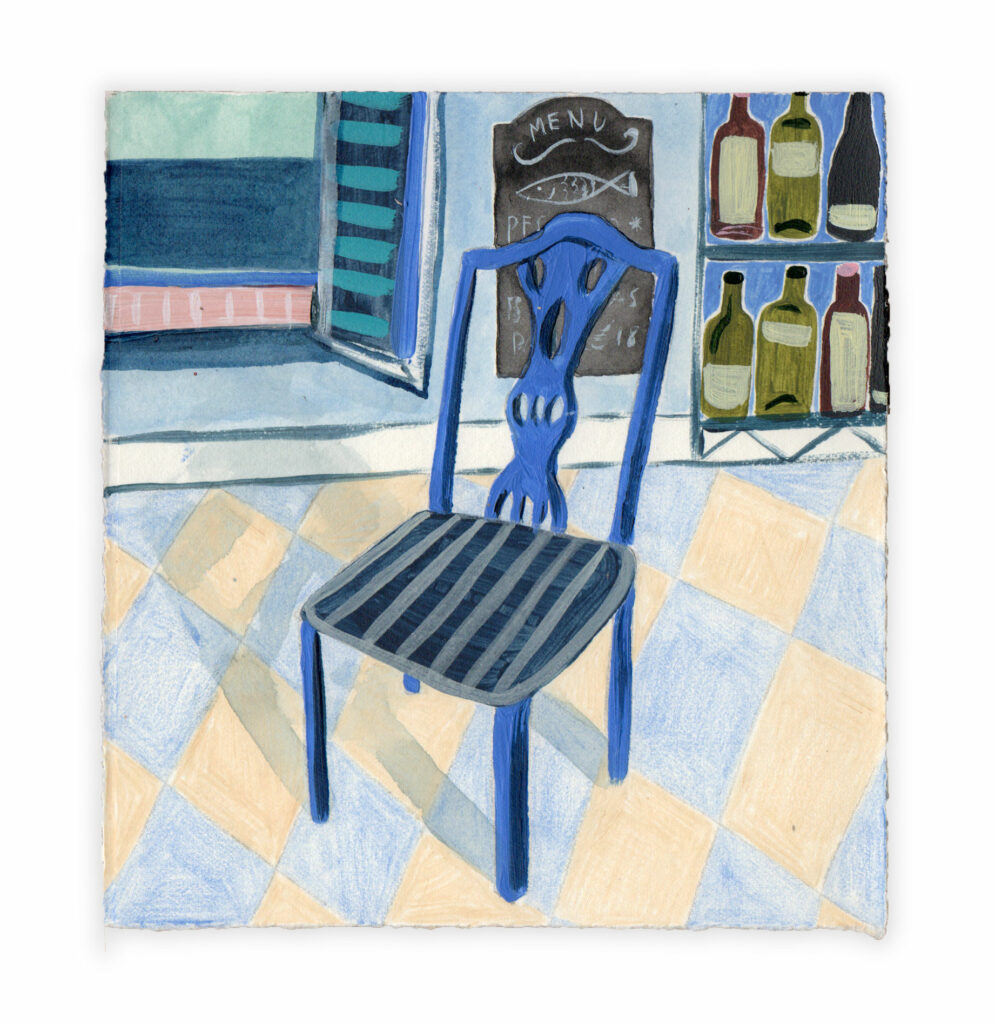
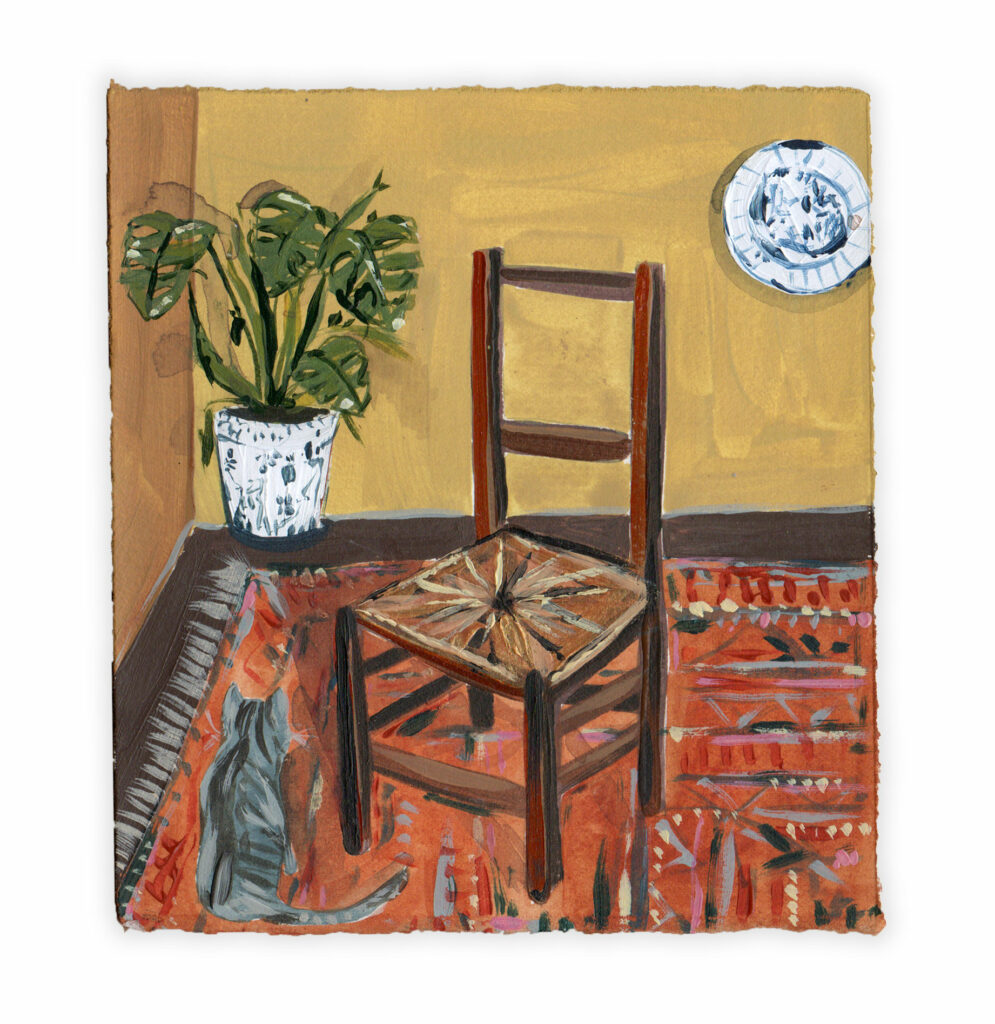
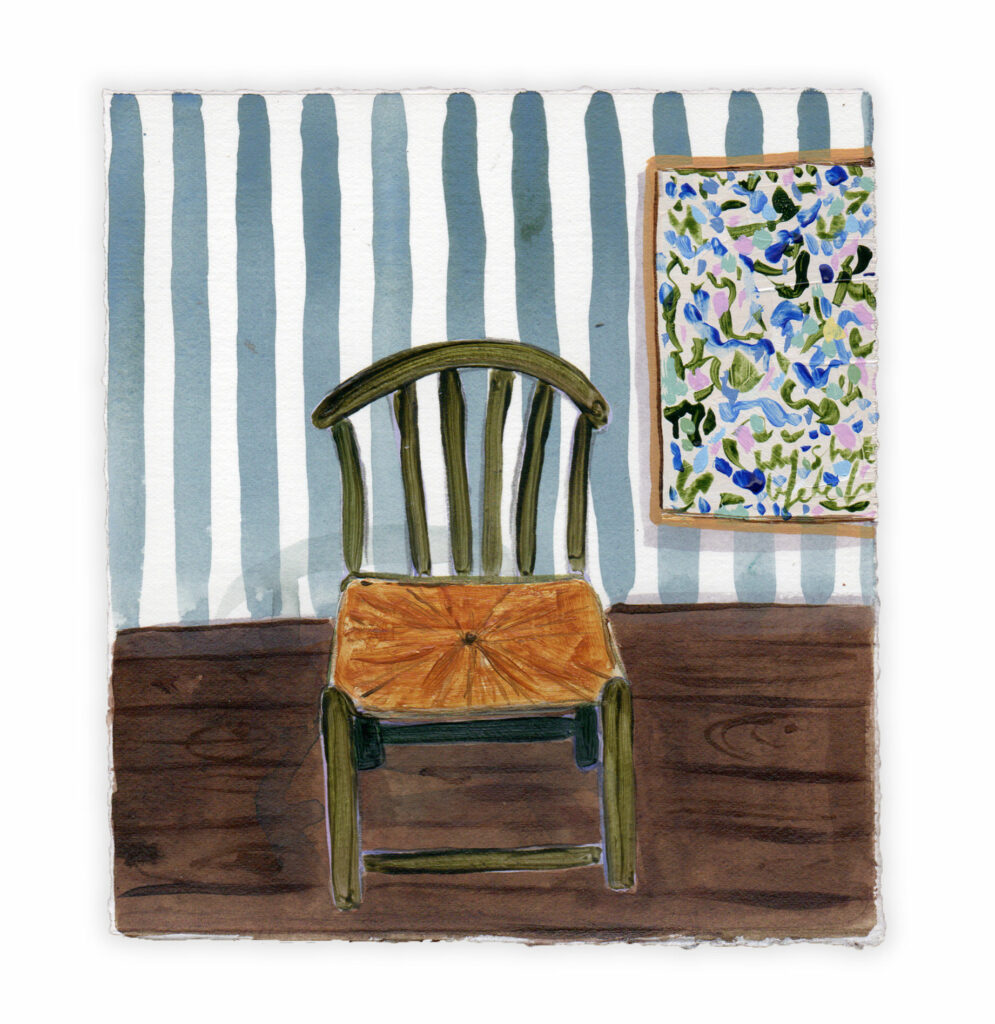
Building an Art Collection: It’s a Meditative Journey
February 7th, 2024 by Emma
I felt the need to write words today, so here’s what happened.
Are you an art collector? Perhaps you aspire to be one.. or maybe you’ve never thought about it. Well, you’ve reached this post for a reason, so let’s take it as a sign. It’s time to expand your collection.. or start one. 😏✌🏼
Collecting art requires a certain curiosity
Being a collector of original artwork is more than just an investment, a hobby or to fill up your empty walls to match the cushions. It’s a life-long, personal journey that can be deeply meditative, often rewarding and an opportunity to reveal a little of your soul to those who would ever come across your collection. Just like meditation, collecting art requires curiosity, patience, focus, an open mind and a willingness to turn inwards and ask yourself questions. You know.. really get to know yourself.. and be open to learning about who you are, what you’re about, why you do what you do, why you like what you like.
Your art collection isn’t just about bringing colour into a room.. it’s also a way to tell the world what you really give a sh*t about. For example, say you purchase an artwork that displays a hilly landscape of a view from your hometown – this could tell people that you like where you live, that you’re an outdoorsy guy or gal and/or you’re quite sentimental about things.. perhaps the landscape triggers a certain memory or is a reminder to appreciate where you are. Another example – your most recent purchase is a chaotic, bold and aggressive abstract that you’ve displayed next to your dining room table. This could show that you’re energetic and bold in character, open to controversial conversations and/or somebody that deliberately wants to ‘make an obvious statement’ in your home.
Your art collection shows the world who you are.
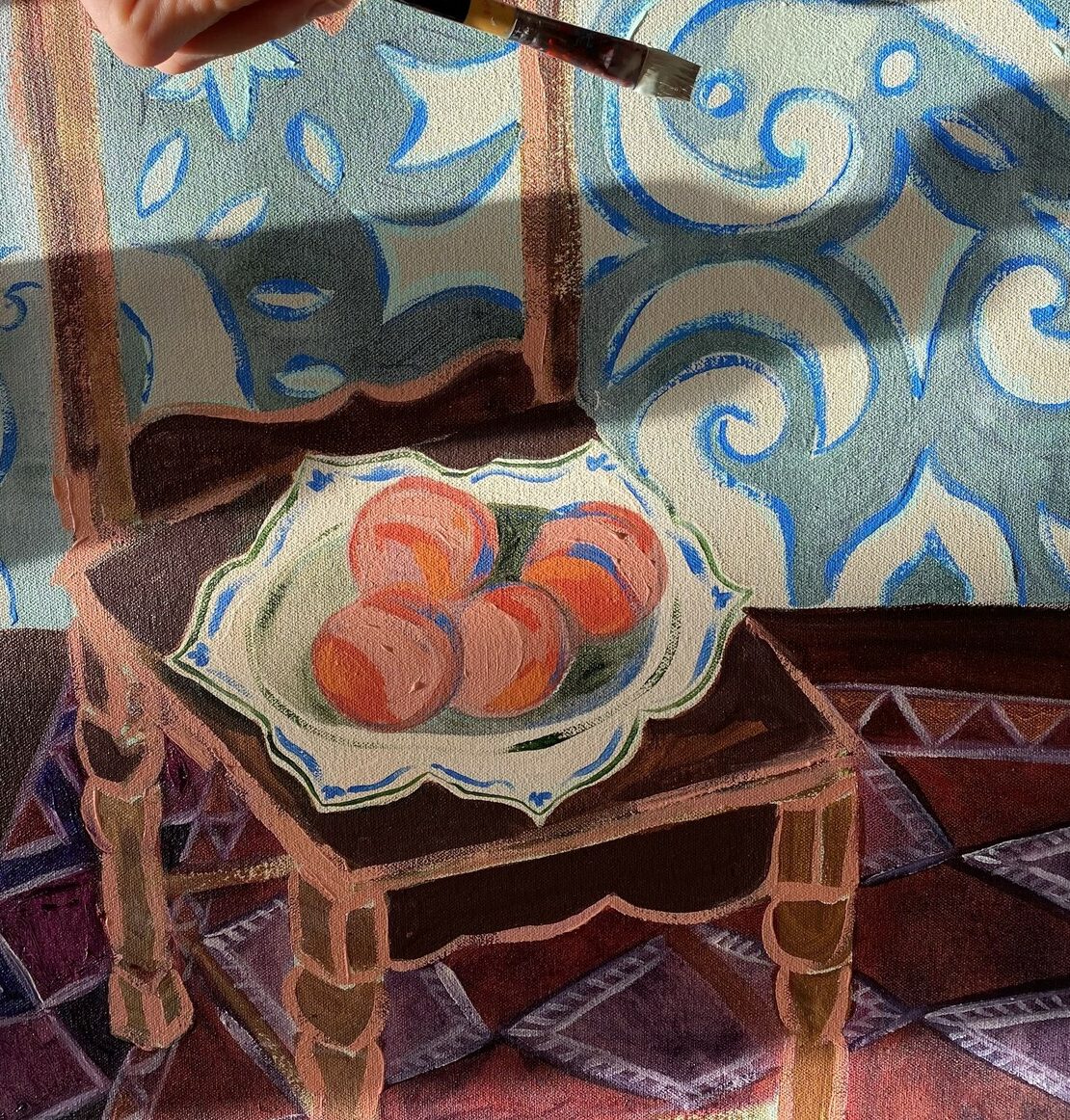
Take your art choices seriously
The art of collecting paintings begins with simple observation. Each piece of art is a visual representation of the artist’s thoughts, feelings, traumas, experiences and ideas. As the collector, you’re not just acquiring a physical object; you’re buying a window with a view of the artist’s mind. And this process of observing, understanding, connecting with and then finally choosing a piece of art can be a meditative practice in its own right – similar to that mindfulness meditation we do (yes, do it every morning!) where we focus on the present moment and/or the cool breath running in and out of our nostrils.
Ok, so if you’re really serious about your status as an art collector, that very act of choosing and trying to work out which piece to get can get emotional. It requires self-reflection; you need to tune in to that inner dialogue, much like meditation mentioned just now. You must ask yourself why you’re drawn to that certain piece, how it makes you feel, and what it means to you.. what connects you with the artist and what would it mean to you to support them? This introspection can help you learn more about yourself and your tastes, just as meditation leads to self-discovery, inner calmness and a readiness to evolve.
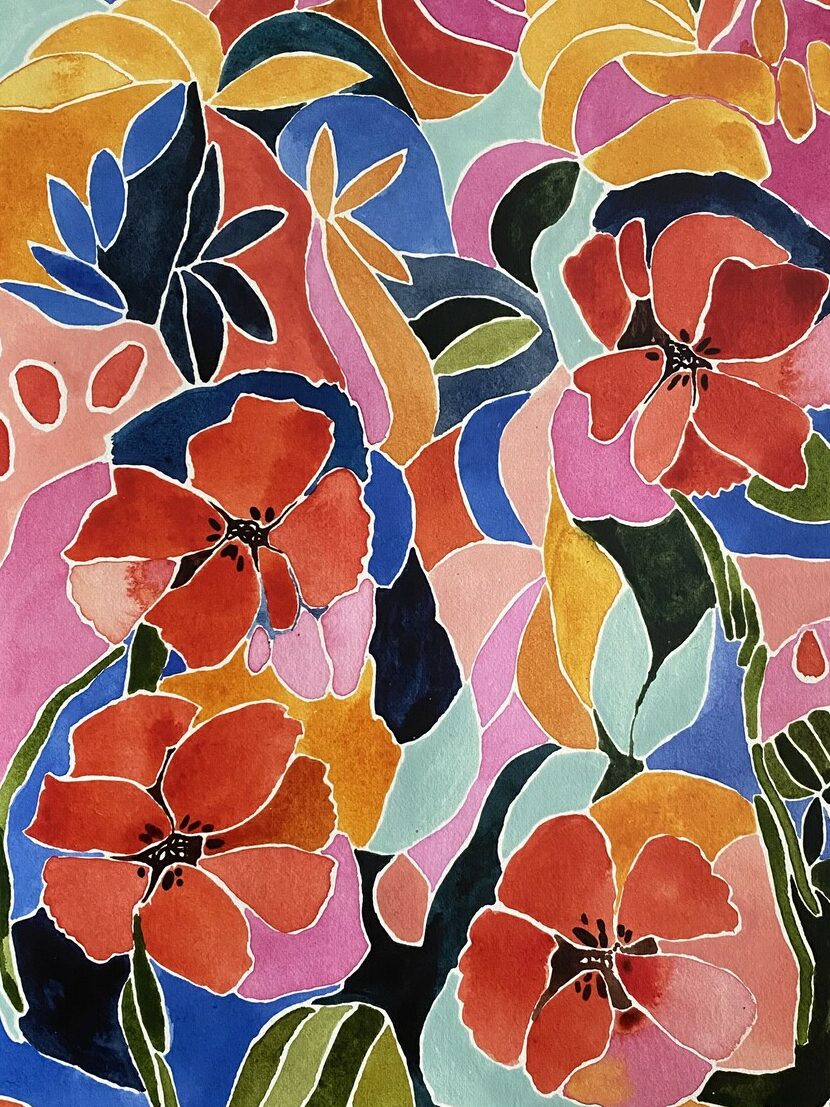
You’re supporting a life
Collecting original artwork also means that you’re supporting the life of the artist (if they’re still living) – this in itself is a gratifying and profound achievement. You should be proud that you’re in a personal/financial position to be able to purchase real artwork and contribute to the life of the artist – you’re enabling us to continue our craft, you’re helping us purchase materials, you’re getting our work seen and you’re validating our existence.
On a personal level, not a day goes by where I don’t feel that flutter of gratitude towards those of you who collect my work across the world. There are quite a lot of you out there nowadays – some of you I talk to on really regular basis, some of you have become dear friends, some of you have built up a rather extensive collection (you know who you are), some of you are saving for your next piece, some of you are still deciding on your first.. whichever stage you are at, I’m so grateful to you. Thank you, thank you, thank you.
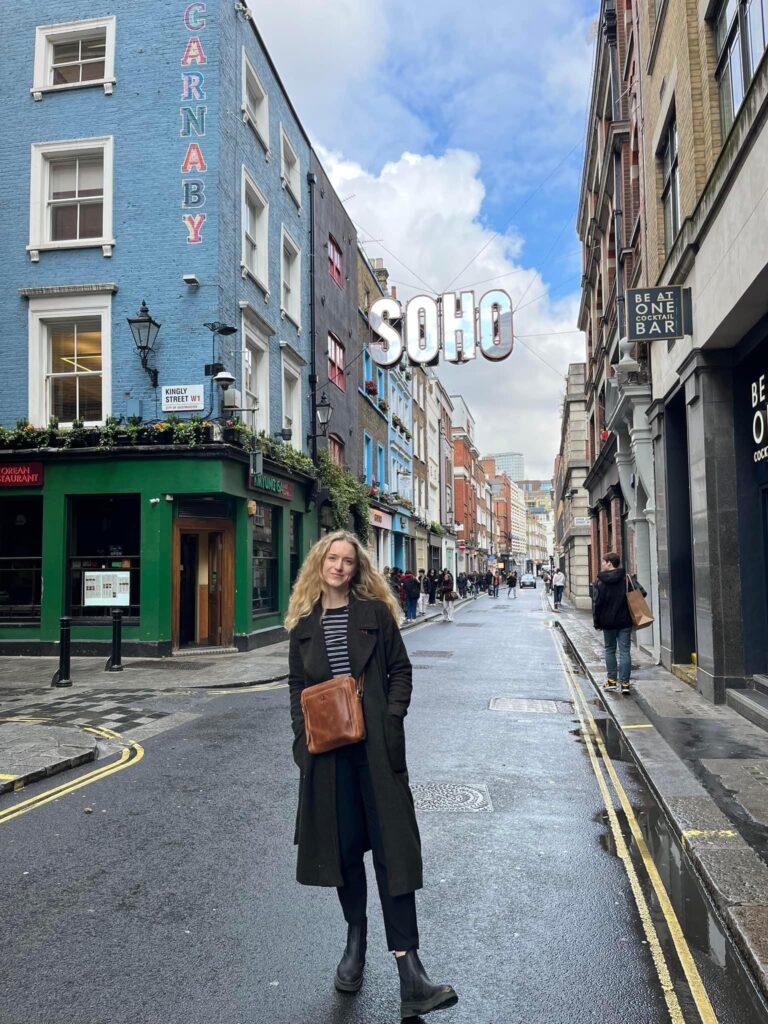
A concluding note
Art. Oh, art. It has this monumental power that sparks all kinds of conversation; it stirs up emotions, triggers memories, catalyses fresh thinking patterns.. the list goes on. By engaging with it, collecting it and surrounding yourself with it, it makes you a special kind of person, you know. I’m not trying to butter your bread; I’m being real here. You’re creative, you’re courageous, you care deeply, you’re in tune with your inner self, you’re supporting lives of others, you’re open..
The next time you add another painting to your collection, take a moment to appreciate the meditative journey. It’s not just buying a print from IKEA. It’s so much more than that. Remember that collecting art is not just about possessing beautiful objects, but also about enriching your soul and supporting the life of another human.
Thank you, thank you, thank you.
Are you interested in a totally bespoke artwork/a commissioned piece? Perhaps an emotive abstract, a Matisse-style still life, a holiday snapshot or large landscape? I’m pretty open to the majority of briefs, so please do get in touch now and I’ll book you into my spring schedule.
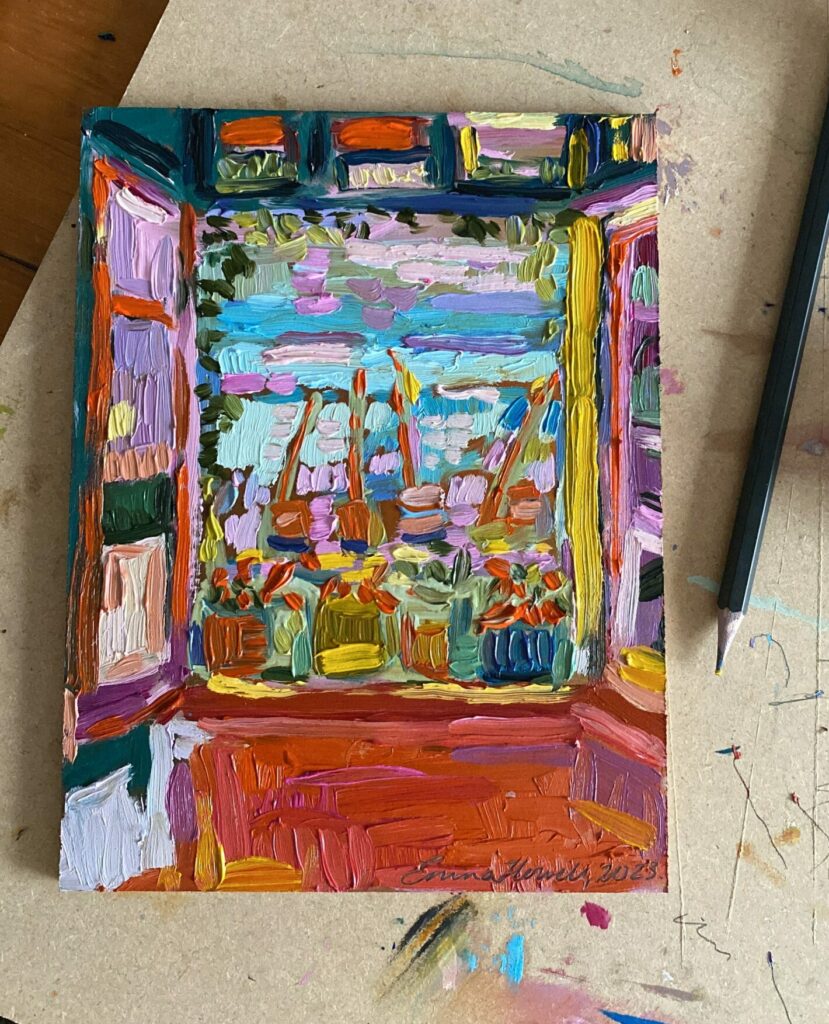
2024 Update: Surrender To What Is & Solo Show
January 13th, 2024 by Emma
I am going through something.
Let’s call it hardship X. It’d be nice to get off this ship, but I can’t really – not when we’re mid-wave or storm (it’s a wave when I’m perceiving it positively and a storm for when I’m.. not so positive). And it doesn’t feel appropriate to publicly write about it – not right now anyway. Maybe later. However, do you know what I can do? I can paint.
Because that’s what I do, right?
I paint when things get tough. If you look at my painting patterns over the last few years, my frenzied bouts of creation usually coincide with a hardship. There was the whole Dad passing a way thing – we all know that one (well, a lot of you do).. and boy, did that one go on for a few years. Then there was the whole covid/lockdown/the world’s gone crazy malarkey.. remember that? That thing that shan’t be named; that thing that felt like last year, but really was almost 5 years ago.. My hands birthed a plethora of art babies throughout that time period and my business/number of art collectors unexpectedly (and beautifully) soared.
Not a day goes by where I don’t feel gratitude for that time – and I know that sounds backwards, bizarre, even barbaric.. but it was really important for me to not stop living or “doing my thing”. I wasn’t going to abandon all of the careful nurturing I was doing for the life I fought so hard for after losing my Dad. I wasn’t going to let anybody or anything hijack my clarity, creativity and conscience.. so in that usual Emma fashion, the paints came out and I travelled far and wide on paper.
Those strange couple of years didn’t just catalyse business and financial growth, they also catalysed emotional/mental/personal growth (I don’t know which word to choose); they awakened a rather dormant soul within. Call it woo-woo, but that’s what has happened. I’ve never been so in tune with my mind and body. I’ve never felt so confident in my life choices. I’ve never felt so real and authentic.
Then hardship X swarmed in like a sh*t ton of bumble bees
..and I mean, they must be all queen bees – the biiiig mothers with sharp stinger arses. And despite that perfectly nurtured clarity and eye roll worthy confidence, I haven’t been able to handle it. That’s right, I fell right back down that dark hole with absolutely no intention of finding a way out. White flags.
Didn’t even want to paint. See ya, paintbrushes.
Well, that was 2023 and it’s now 2024.. and I’m thrilled to announce that 2024 is going to be nothing but sublime. Hey, I’m no fool – I know that curve balls in life happen all the time, and I won’t naively kid myself into a perfect, curve ball-free year (despite being a pretty sufficient batsman nowadays).. but what it is going to be is a year of peaceful and conscious acceptance of the now and the what is.
It’s taken a few months of solid inner work, therapy, dollar spending, reading, writing, voice-clipping (you know who you are) and a recent but temporary abandonment of my Instagram account .. but guys and girls, although I still have a lot to process and a “journey” to go through, I’m officially out of the hole – and however alluring it can be, I’m staying out.
I’m ready to paint.
This soul has a lot to say and I’m going to say it in paint, pencil, charcoal, ink, whatever I feel like using when the time comes. Expect an eclectic mix of abstracts, still life and perhaps landscapes (or mind-scapes); a body of work to inspire, enthral, open minds and to celebrate life.
These pieces that I speak of will all be showcased in my next solo show coming up this summer.
And that show is called Soul.
I’ll see you there.
Soul details:
June 28th – July 11th 2024 at Sixteen Gallery in Cheltenham.
With very, very special guests Munson Guitars.
For a private viewing before the launch night, make sure you’re signed up to my mailing list where you will receive more information on this opportunity.
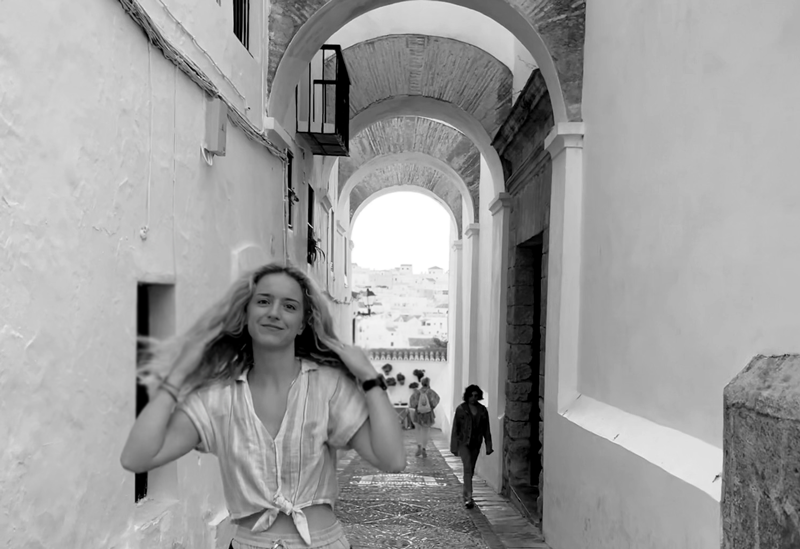
I’ll be OK 😀
Absolutely vital reading list:
The Miracle Morning by Hal Elrod
The 5AM Club by Robin Sharma
The Art of Living by Bob Proctor
Atomic Habits by James Clear
The Celestine Prophecy by James Redfield
The Alchemist by Paulo Coelho
Snapshots (2023): a 50-piece collection to honour the sublimity of being human
April 17th, 2023 by Emma
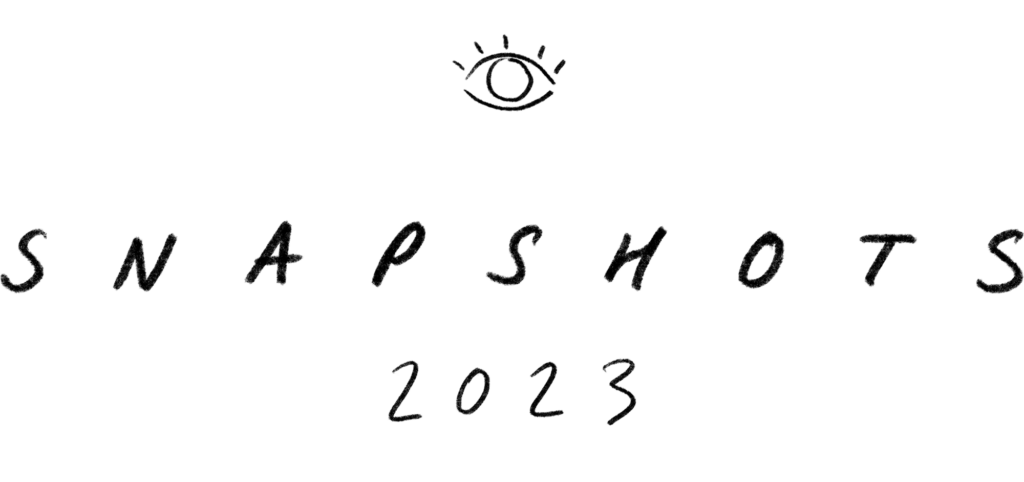
It’s official.
A brand new collection is in the making.
And you’re going to love it.
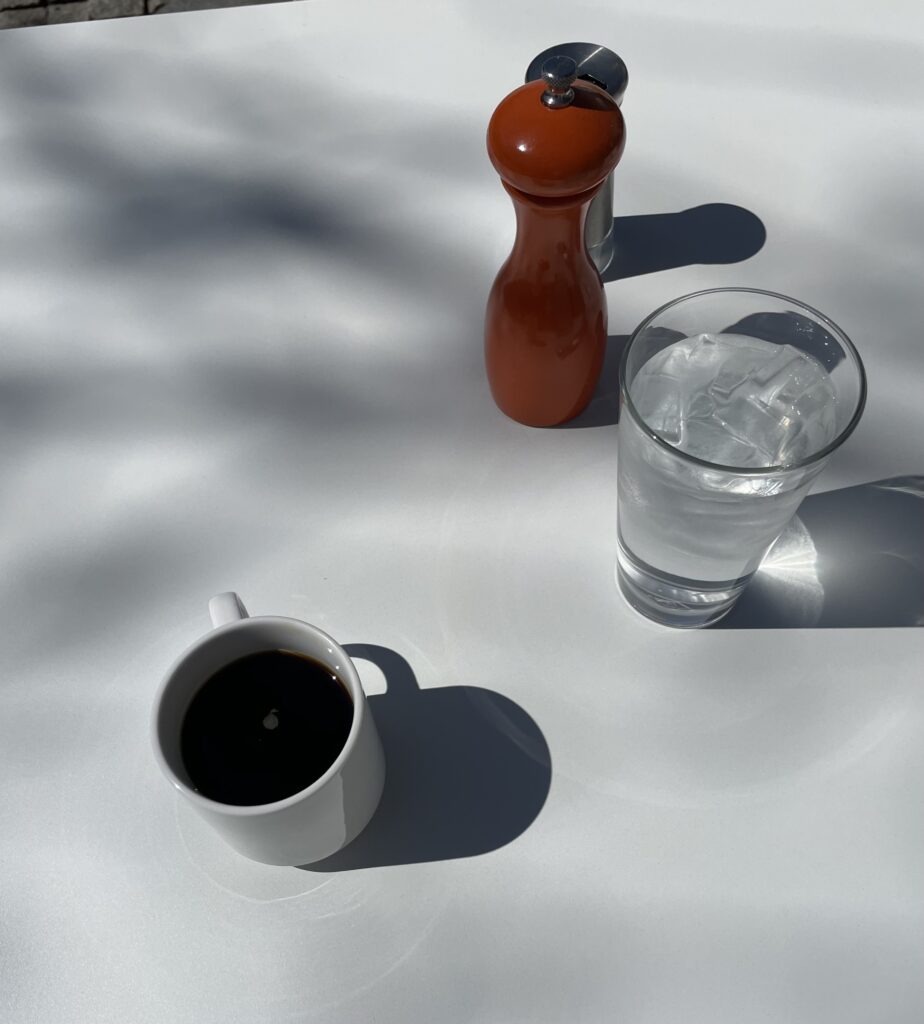
Snapshots (2023) is a 50-piece collection of polaroid-style original paintings, depicting scenes, vistas and moments submitted by my friends, family and collectors (aka you) around the world. It’s important to appreciate the small things and see beauty in the everyday. These moments in life are what makes each of our journeys unique, and I want to celebrate that. The body of work will be comprised of a mixture of abstract landscapes and still life pieces – depending on what submissions I get, of course.
The Title
Snapshots was sneakily stolen from my final project at High School Fine Art class (13 years ago). My focus was on the unposed and beautifully candid moments of life. I recall one of my final photographs being of a little girl at the zoo, staring at a snake in total bewilderment – such a wonderful moment to capture.
Now, I’m yearning to see more of life’s candour. From a simple bowl of fruit and a bottle of wine on the shelf to a weather-worn door and a windy cotswold hill view. We all have objects, views and moments in life that make us stop and smile. And this collection is going to celebrate yours (and maybe a couple of mine).
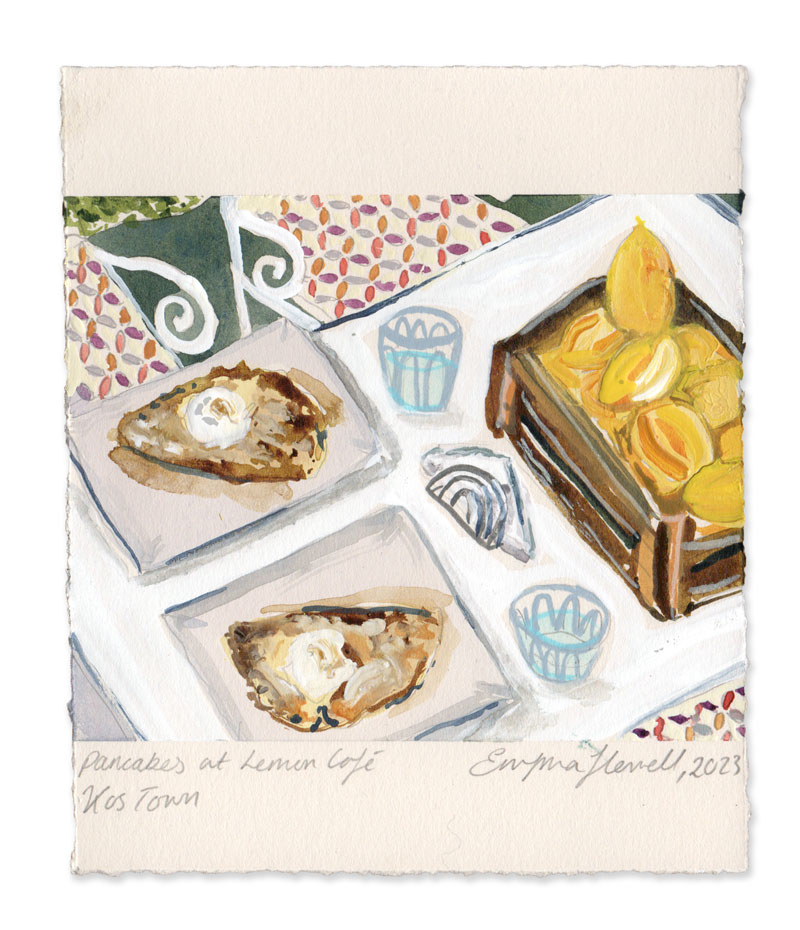
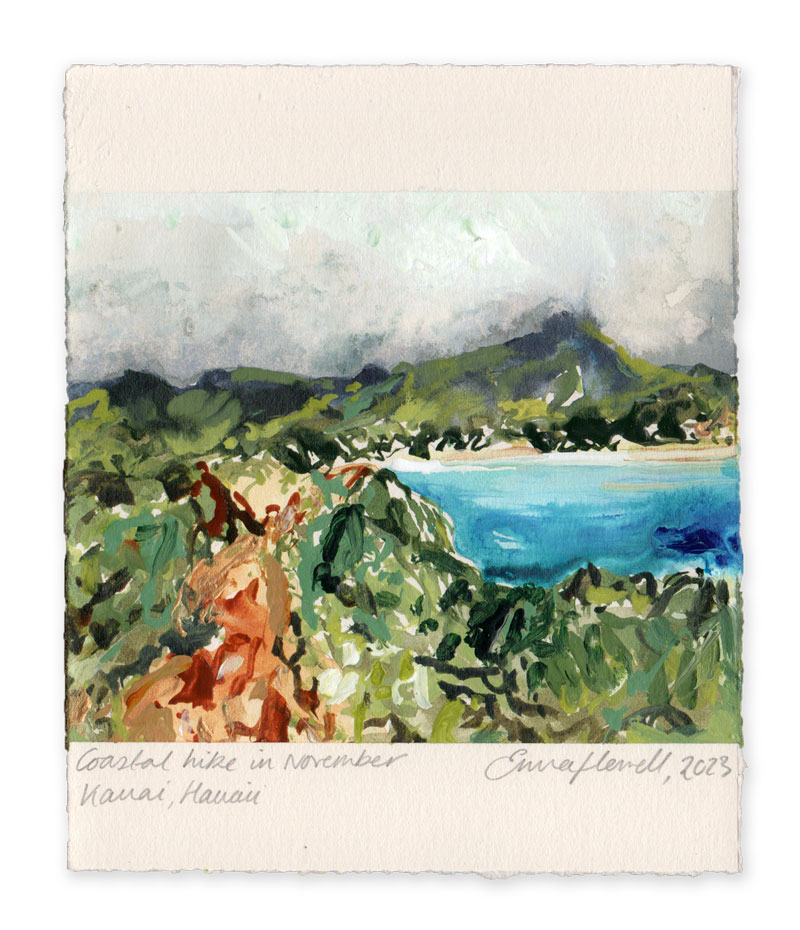
The Aesthetic
As a sporadic and multi-styled painter, I feel a collection like this will put an exciting (although intimidating) spotlight on my versatile hand and scattered mind – my abstract, still life and landscape skills will certainly be put to the test. To entice the eye and emphasise the image, the final pieces will have a polaroid-style aesthetic (see above).
Be that as it may, for this collection to truly come to life, I first need a wide range of snapshots. A photograph of something that catches your eye or makes you smile. I need you to show me a snapshot of something you want to remember.
Perhaps a magnificent mountain view, the best croissant you’ve ever had in Paris, your feet in socks and sandals, your last cup of tea with too many biscuits, plant pots on your window sill, the eclectic mix of books on your bookshelf, the most incredible plate of calamari in Greece, the empty glasses on a table after a long night, the moody weather outside your window… you know, the things that make you human; the things you’ve seen with your eyes and/or touched with your fingertips. I want to honour these moments of yours, just like I honour mine through the creation of art.
No humans, no animals and no pornography – thank you.
Think views, landscapes, buildings, objects, still life.
You can submit your snapshot via the button below. If you have trouble accessing the form, please send your snapshot along with a title/sentence about it to [email protected]
Artwork Details
- Only 50 original paintings
- Fluid acrylic and pencil on paper
- 5 x 6 inches
- £75 each (with bespoke framing available)
- The collection will launch on my website (date TBC)
- Not all submitted snapshots will make the cut for the collection
Optional Challenge
If you’re interested in collecting a snapshot painting, purchase someone else’s submitted memory – not your own. Spread the love, share stories and let us cherish each other’s simple moments in life.
Thank you for helping this collection come to life.
I can’t wait to see your snapshots.
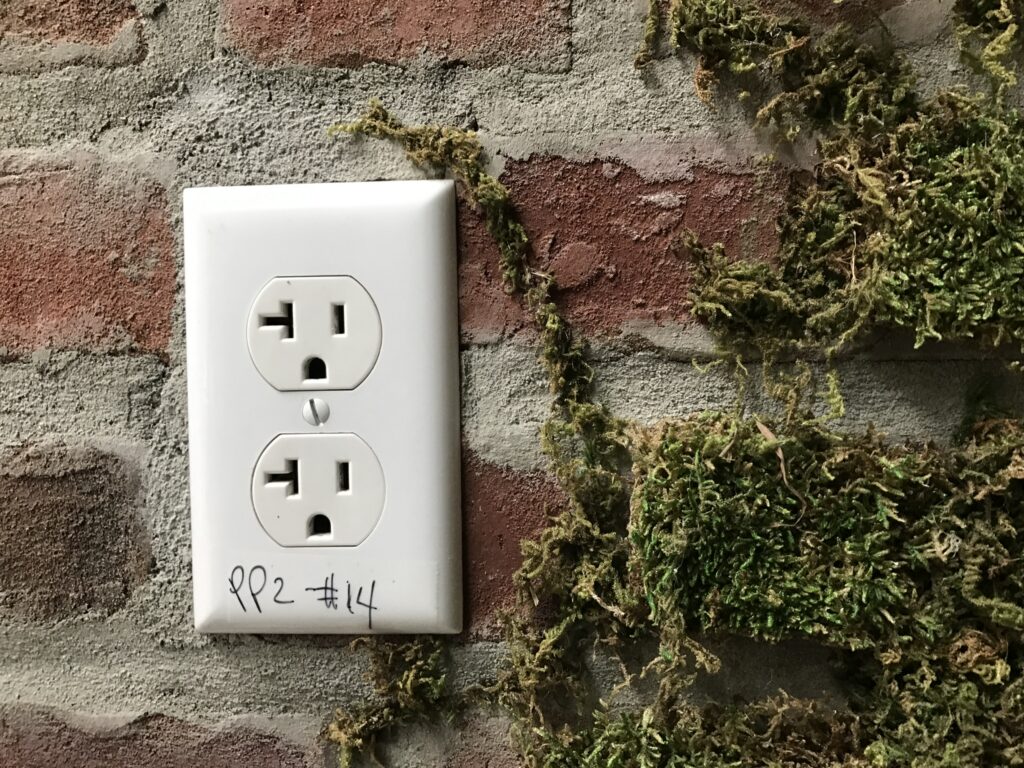
Abstract Art vs Still Life: Painting Memories And Being Human
March 23rd, 2023 by Emma
As an artist who covers a wide range of styles – abstract, landscape, still life, sketching, digital drawing etc, I often get asked “what is your favourite way to paint?”
Abstract painting feels incredibly innate for my hands and head; my go-to thing for a meditative exercise and indeed the style that kickstarted my career as a professional artist. Painting in an abstract manner is a handy tool for when you’re feeling lost, angry and/or depressed. If you allow your hand to hold a paintbrush to drive your feelings, marks manifest and colours collide, consequently prompting a wave of relief to wash over. You can see your feelings on the surface in front of you, which actually allows them to become external instead of internal. I suppose it’s a little like frantically writing out your woes in a diary. Granted, this relief can be momentary.. but over time, I feel it helps you accept a situation or trauma. It makes the problem tangible and physical; an object you choose to view and a physical activity you choose to do – instead of being a scary, tangled up web in your head.
Abstract painting, for me, is also a way to uniquely translate sounds, sights and feelings experienced from life. When I want to quickly document a moment, in a non-literal way, I’ll jot down the marks and colours that come to mind when I’m having an interesting experience or if I’m enticed by something. See excerpt from one of my artist statements:
“A deep navy hue could be a woeful moment or the colour of a gentleman’s jacket; a wash of pale grey could be a loving conversation or a typical British cloud; an earthy green could be a Cotswold hill or the colour of a weathered road sign; a quick, rough mark could be a moment of frustration or a tyre blow-out on interstate 81”
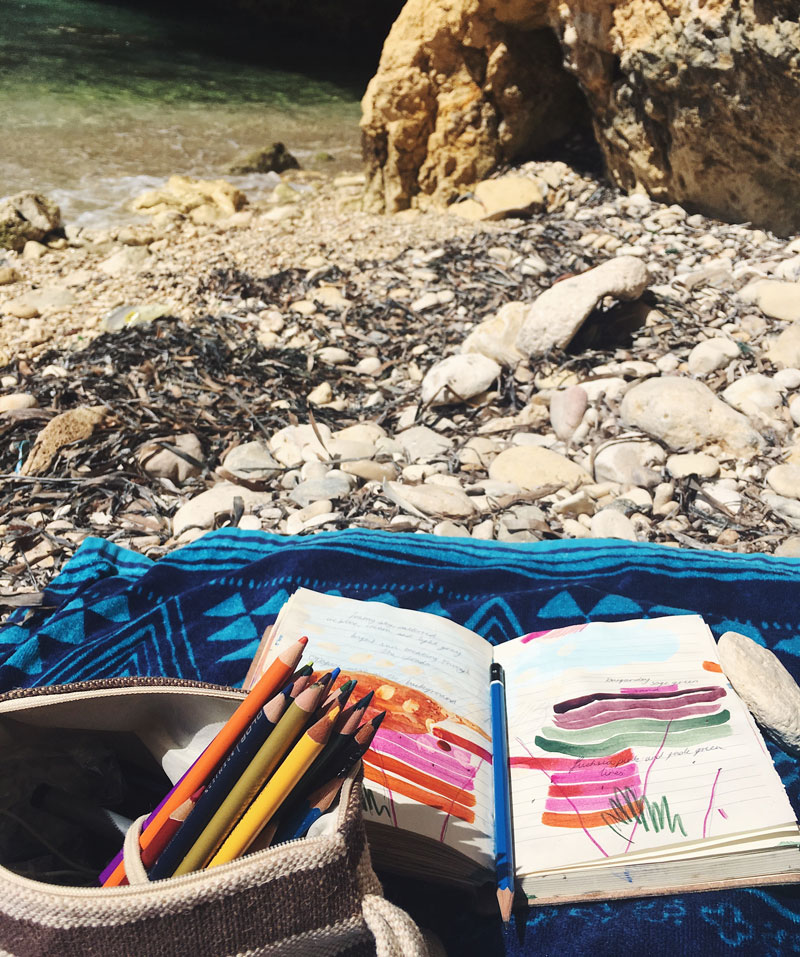
Be that as it may, totally abstract painting isn’t the answer to the question “what is your favourite way to paint?“. (You’ll find this out in a bit.)
Yes, this style is overwhelmingly natural to my senses and brings a lot of comfort, but it’s me dealing with something or working to process something. That isn’t to say that all of my abstract paintings represent sadness or brokenness – not at all. On the contrary, you could say that they all represent healing, self-development and acceptance. I’m more referring to the reasons behind why the abstract obsession came about for me in the first place – it started with a tragedy.
Looking at my experience with abstraction as a whole, I often see the broken Emma who had just lost her Dad; an Emma that was working through one of her greatest fears of losing a parent and an Emma who used this type of painting to fight with the encompassing waves of grief.
Nowadays, abstraction has thankfully become a more positive and energetic part of my artist identity. Despite some of the sad words I write above, I’ll never stop painting abstracts – and the hundreds (maybe even thousands) of paintings I have created over the last few years will continue to live on and I’m grateful for that. They bring joy, brighten living spaces and spark interesting conversations – so for that, I praise the spectacle of abstraction.
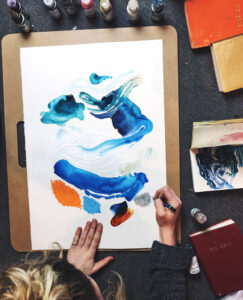
So, what is my favourite way to paint?
It’s actually raw life documentation in the form of still life that I enjoy the most, and what best represents my identity as an artist. This method of art creation is a tool that helps me cherish, share, reminisce, smile, look forward and appreciate; all things that radiate positive thinking patterns and ignite inner self-worth/confidence.
Sketching observations from life, taking a snapshot and documenting candid moments is a necessity for me; a way to love and appreciate the life I’ve been given (hello deep). You can take photos, sure (and I often do) – but there’s something about connecting my mind, my senses and hands (plus paint and paper) to a moment that makes me remember it better and a way for it to live on. I’m also rejecting the limited, digital barricade that we often put between ourselves and actual life; those devices that make us resist reality, smother our authenticity and diminish our innate creativity. (You can probably guess what my views are on Chat GPT.)
My honeymoon, for example, Jon and I were at Eleftherias Square in Kos and we found a café called Lemon. Many of you will know that I’m creatively hypnotised by lemons. They make an appearance in a lot of my work. I’m obviously seduced by the colour, the smell, the metaphors around them, I don’t know. Anyway, I was enticed by this café, Lemon, and we both sat there in these boldly patterned chairs, watching the world go by. We ordered two crêpes and two glasses of water (yeahhh, we know how to party), and I remember feeling just pure contentment. So content to be there, with Jon, the sun on our faces, surrounded by lemons, watching Greek kittens dance and enjoying bloody great crêpes smothered in Nutella. I sat there wanting this moment to last forever – I remember thinking it. So, I sketched it and later painted it. And now the memory lives on, with a lovely collector here in the UK. This is just pure magic for me.
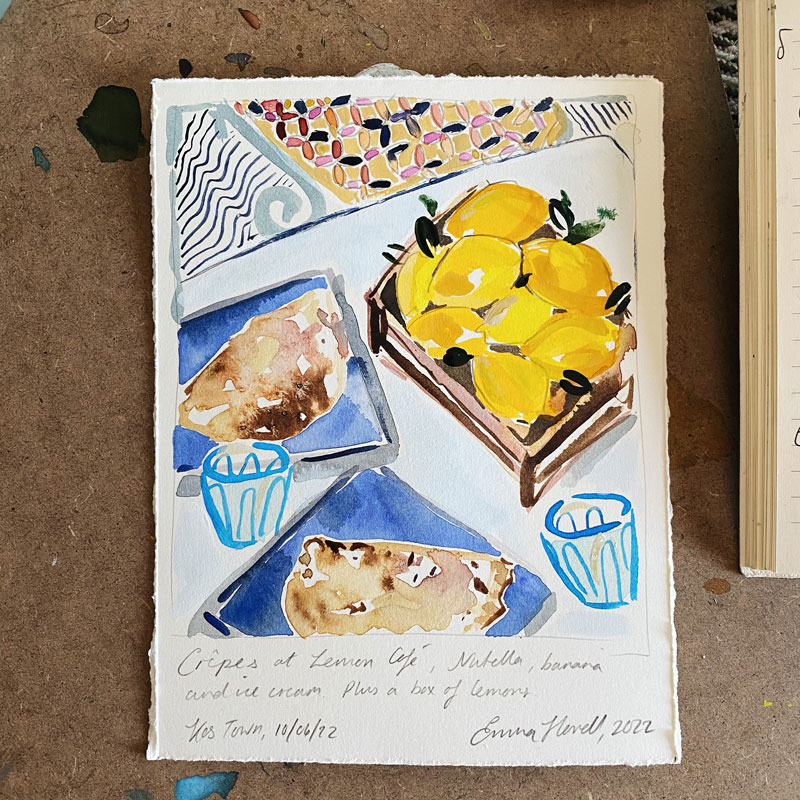
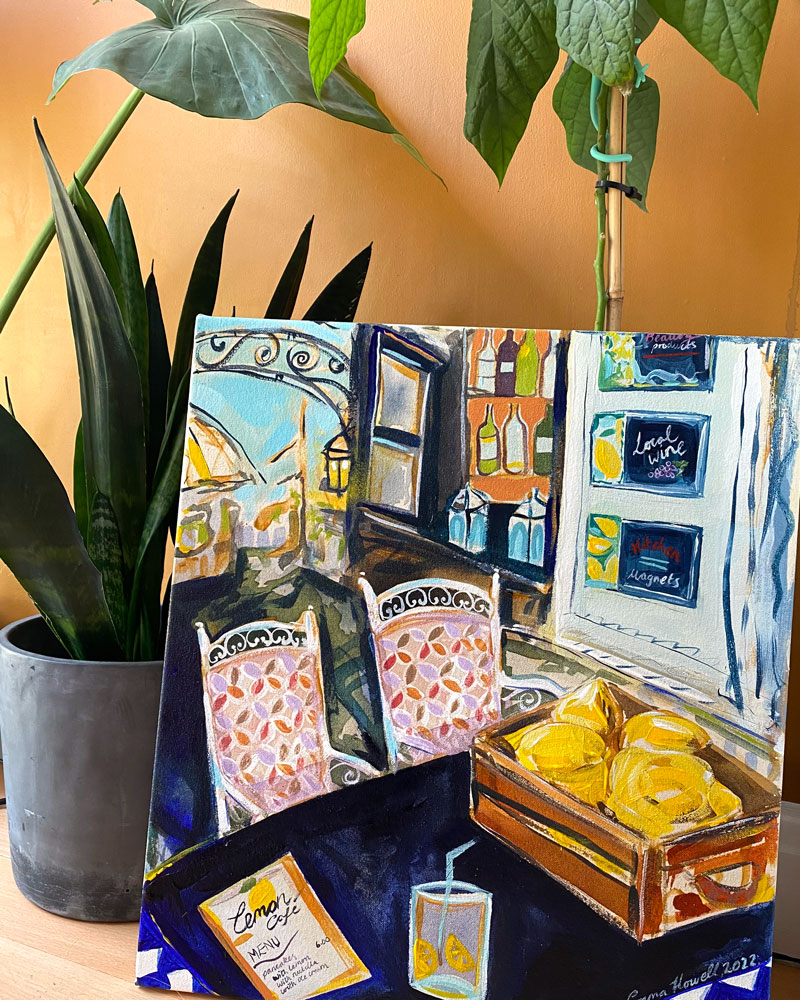
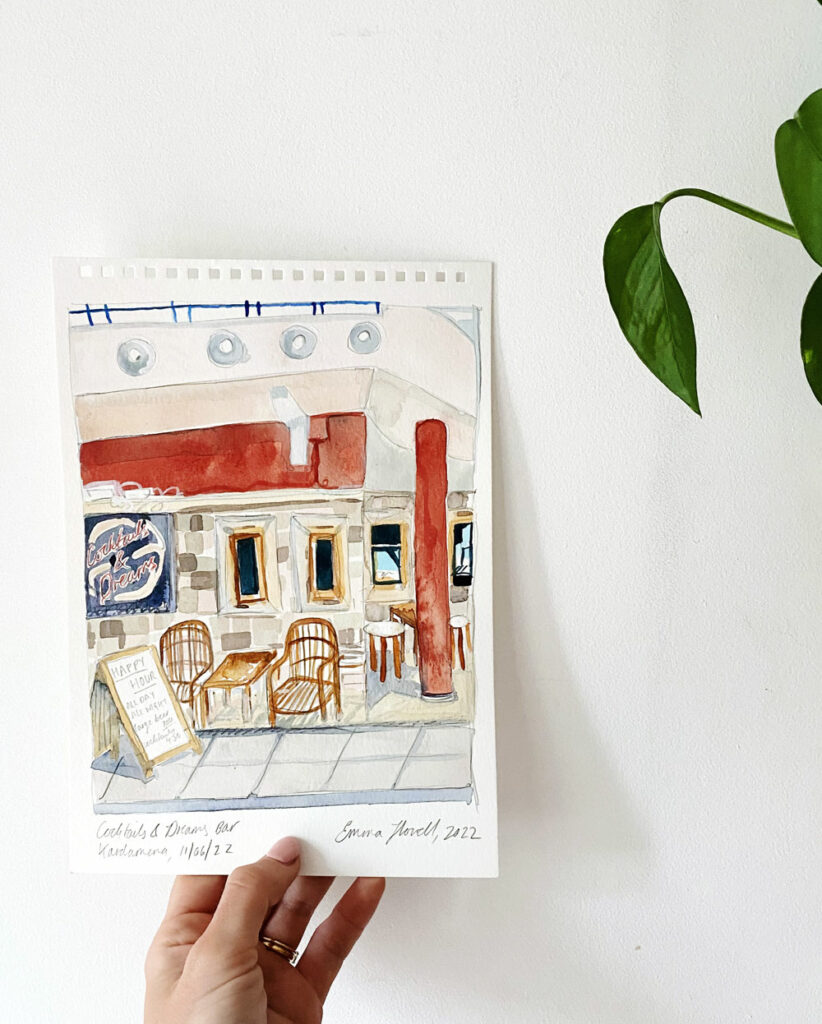
These painting practices allow memories to live on outside of the mind and photo albums; a tangible memory that will live on until it’s physically destroyed. Creating art like this is showing the world who you are, where you’ve been, what you’ve seen – all of the charming, individual things that make you human.
Another moment comes to mind: I was sat in a coffee shop on my own before an appointment (I was too early – standard), and I had one of my journals with me. In front of me was a couple that must have been on their first date – they were sweetly awkward and she didn’t want to share his lemon drizzle cake.The guy couldn’t find a drink he wanted. After quite a few minutes, he finally decided on a chocolate milkshake and the barista said they were out of it. Then the decision making had to start all over again. Me being me, I obviously documented this moment. And they’ll never know this, of course. Such a brief snapshot of their life that I’m sure they’ll forget, and there’s me in the corner scribbling it all down.
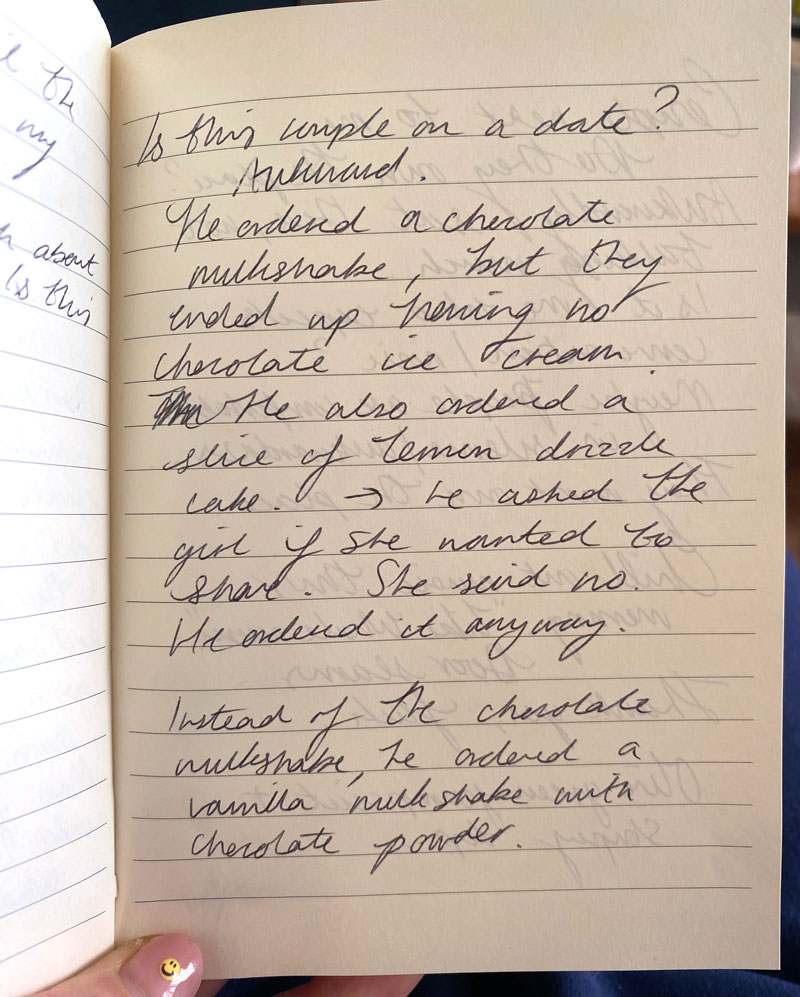
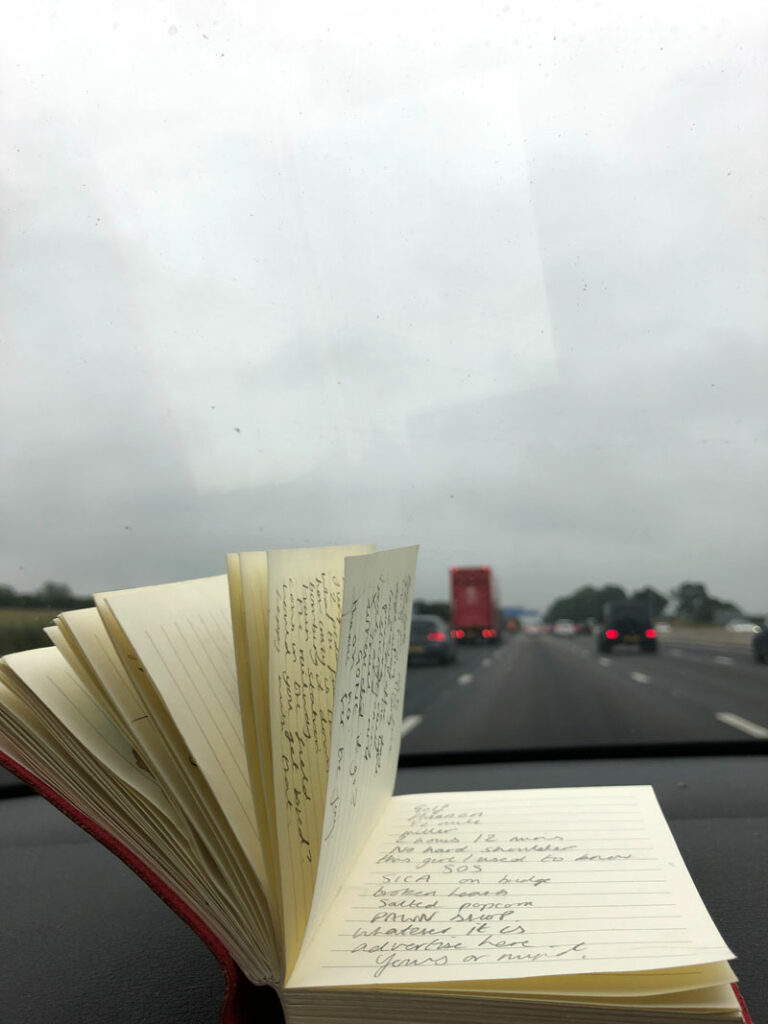
I smile when I think about that awkward lemon drizzle cake comment – maybe it’s just me that is moved by these brief scenes from life, but they seriously give me the urge to paint. Life seems to go by quickly the older you get (do you know what I mean?), so documenting experiences in the way I do helps to slow it down a little. And I make an effort to find beauty in the mundane. A towering stack of lemons in an old wooden crate, each carefully placed, differing shades of yellow overlapping each other and the puckered, waxy texture that you just have to touch, maybe even take one home. These kind of visuals in our everyday are usually overlooked, under appreciated and forgotten. Well, no way José – not in this artist’s lifetime. My eyes and ears are always open, and a painting will no doubt be at the other end.
Other humans are also fascinating, hence why we all love a good old people watching session (you know you do..). So, a lot of my inspiration actually comes from those around me – and they (you) don’t even know it. Viewing, admiring and collecting other people’s life moments (not just my own) just feels so marvellously endearing and a precious sentiment. Mentally, physically and emotionally, human connection is vital and we’d feel lost without others.
So, my favourite way to paint? Life snapshots, candid drawing and writing, documentation of moments, still life – just as it is, perfectly imperfect.
N.B. I am aware of the hypocrisy that I’m on my digital device now, writing this, posting photos of my practice and interacting with you.. but I don’t think carrier pigeons would work out nowadays. I’ve also completely done my neck in, so I’m glued to the sofa today. Laptop/admin day it is.
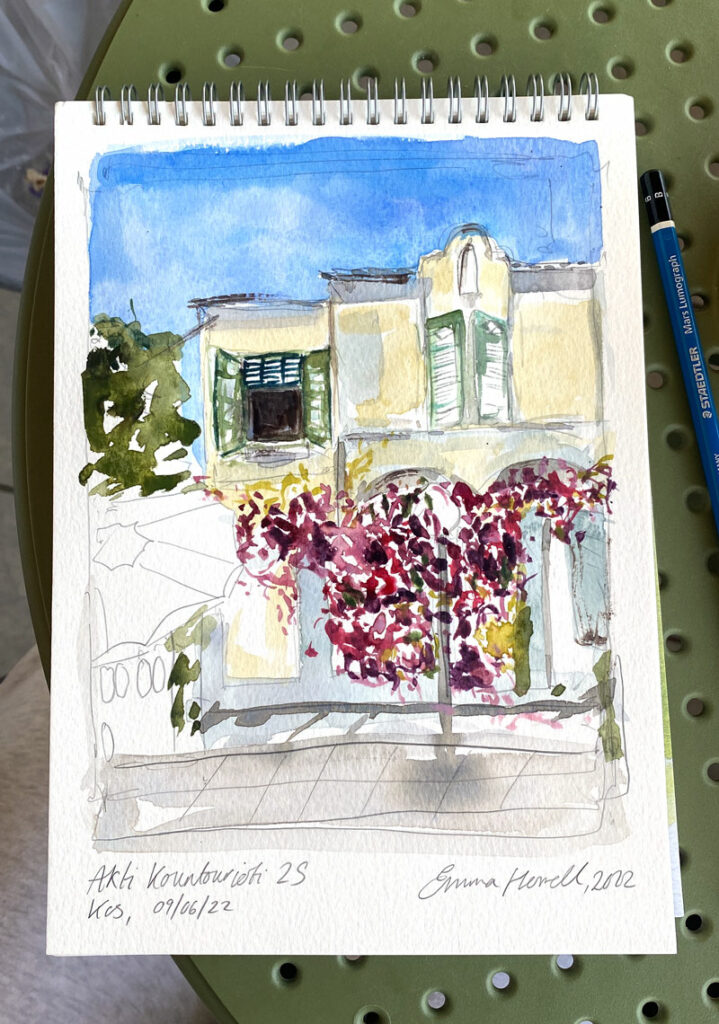
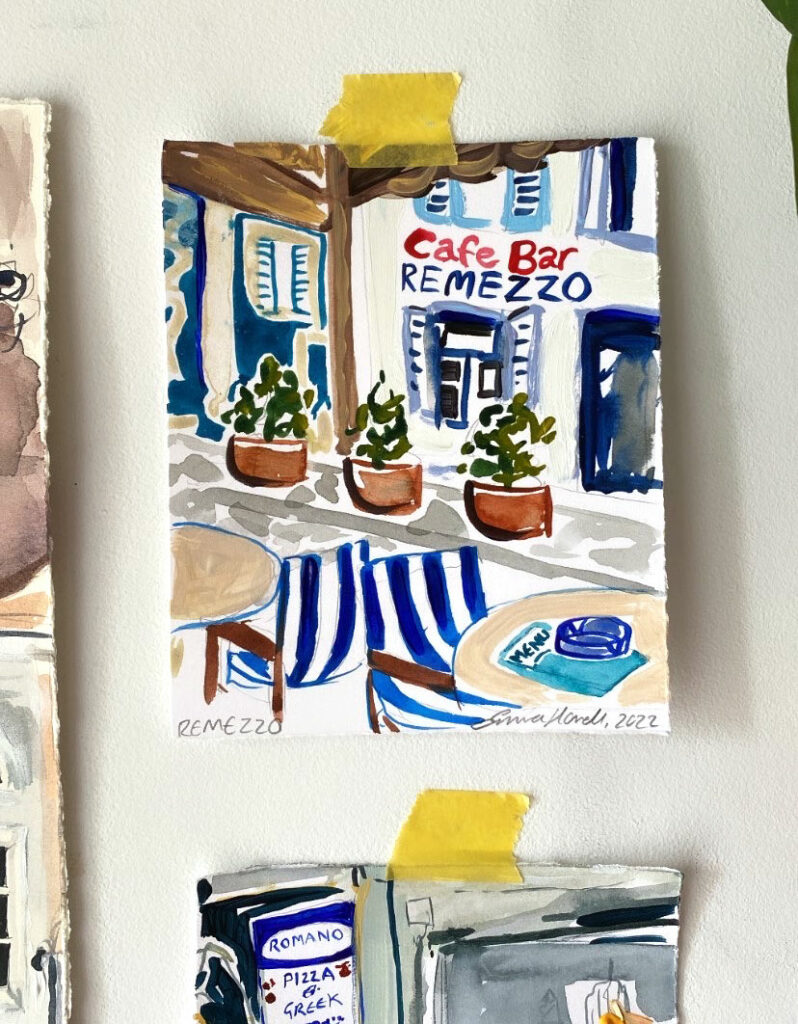
Collaboration With Sculpd: Finding Your Inner Painter
October 19th, 2022 by Emma
Earlier this year, U.K. pottery aficionados, Sculpd, approached me to try out their up and coming Abstract Canvas Painting Kit. Of course, I said yes. As someone who truly believes that we should all dip our toes in the water of our own individual creativity, I loved the idea of a ‘novice’ or someone who claims they ‘can’t paint’ having a go at building their own masterpiece from scratch, at home.
The team came to visit me at my last exhibition at Sixteen Gallery, where I was filmed putting their kit to the test – building the canvas frame, stretching the fabric and then slathering the soft acrylic paint across the blank surface. But first of all, I experienced the unboxing of the kit, just as a new customer would – and I’ve got to tell you, it’s pretty epic.
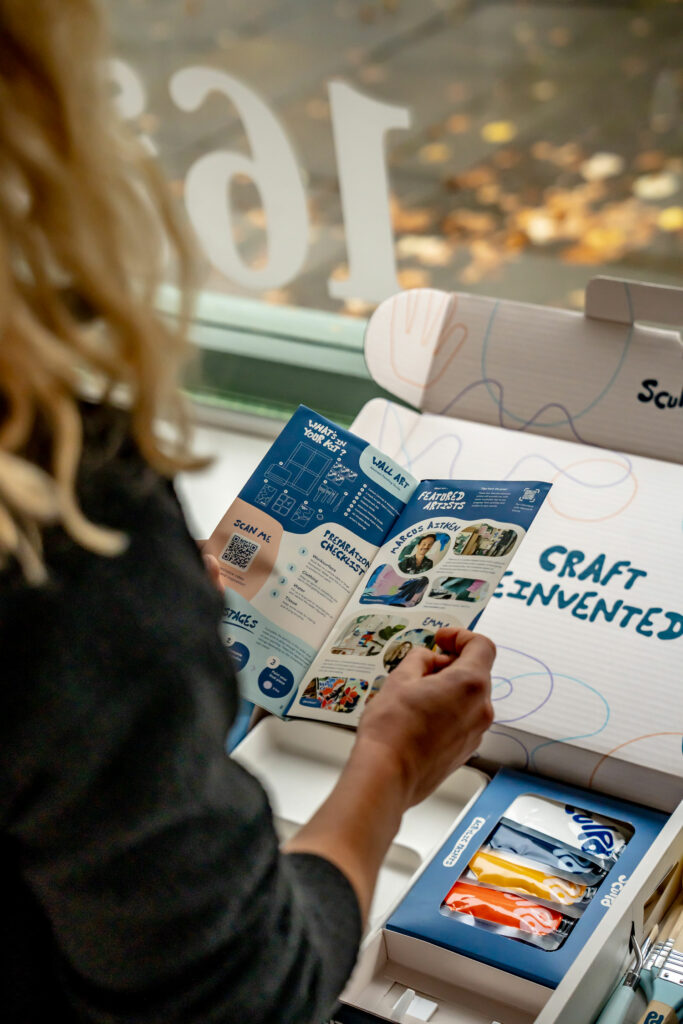

You’ll find a thorough but simple step-by-step guide on how to create your own abstract painting, with tips on composition, mark-making and knowing when your masterpiece is finished. In addition, you get a perfect range of painting tools (brushes, sponge and palette knife), a sturdy palette with compartments, five shades of silky soft acrylic paint (in a bold, neutral or pastel colour scheme), a study book to practice your colour mixing and mark-making, all parts to actually build the canvas and hooks to hang it once complete. Honestly, they’ve smashed it.
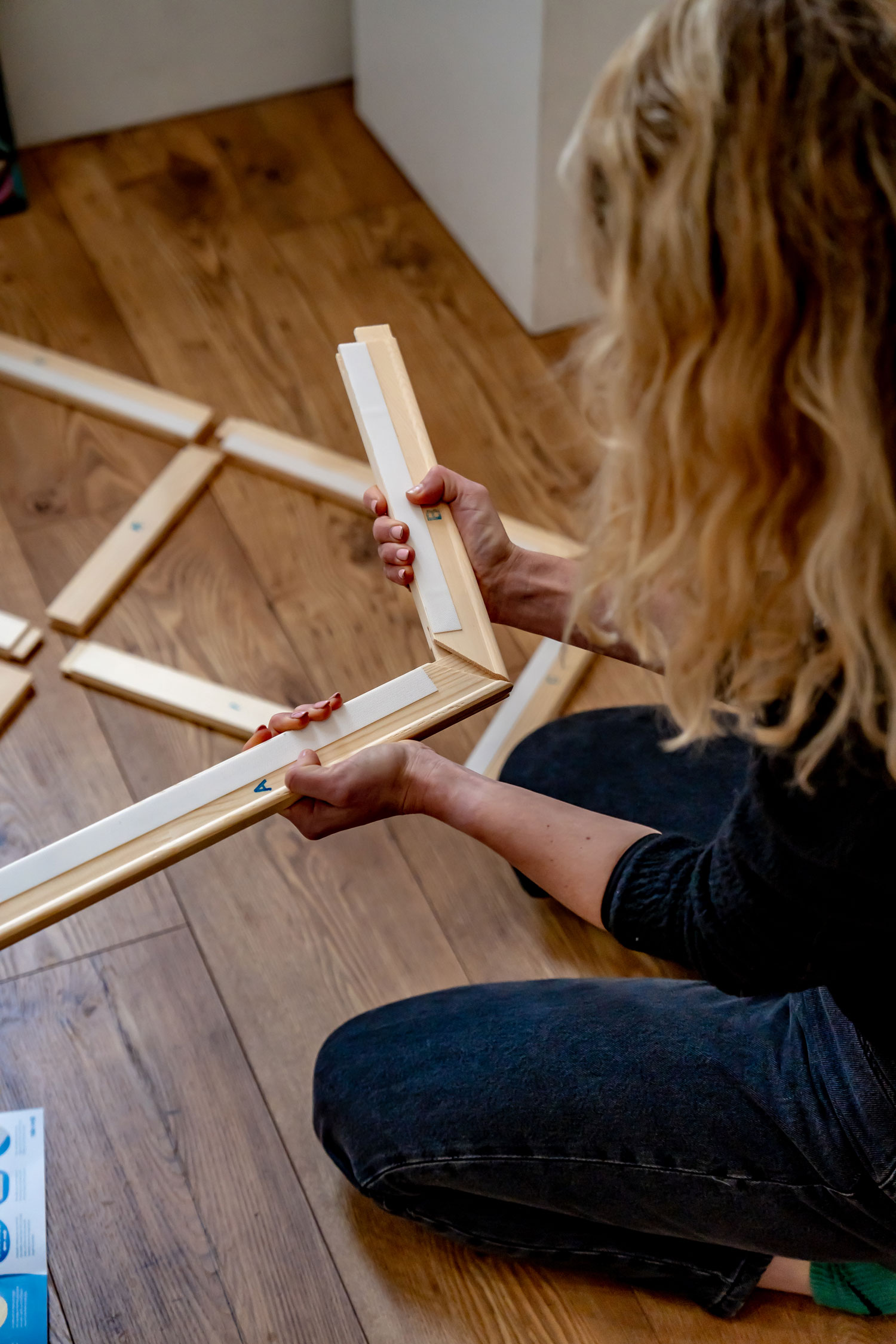
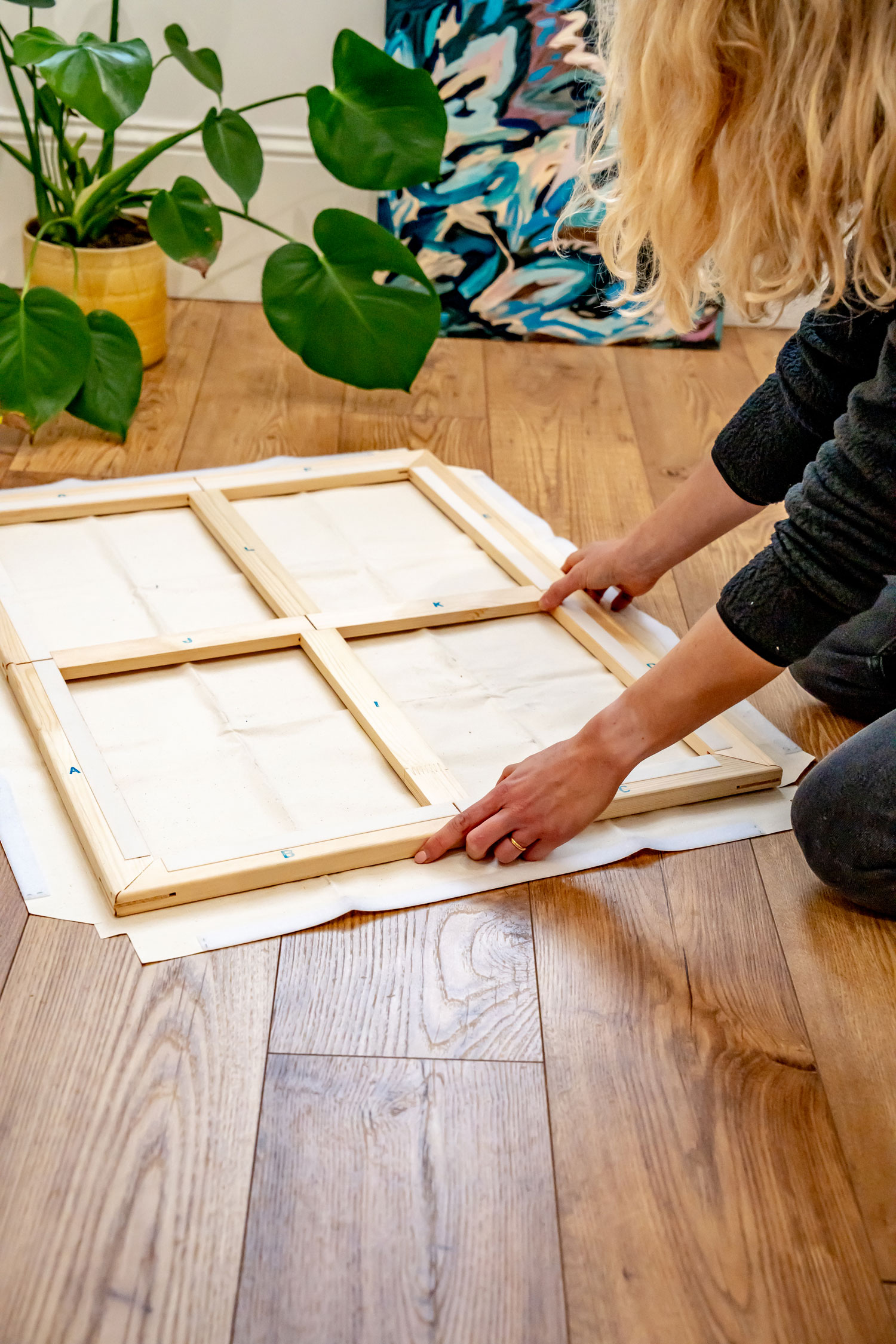
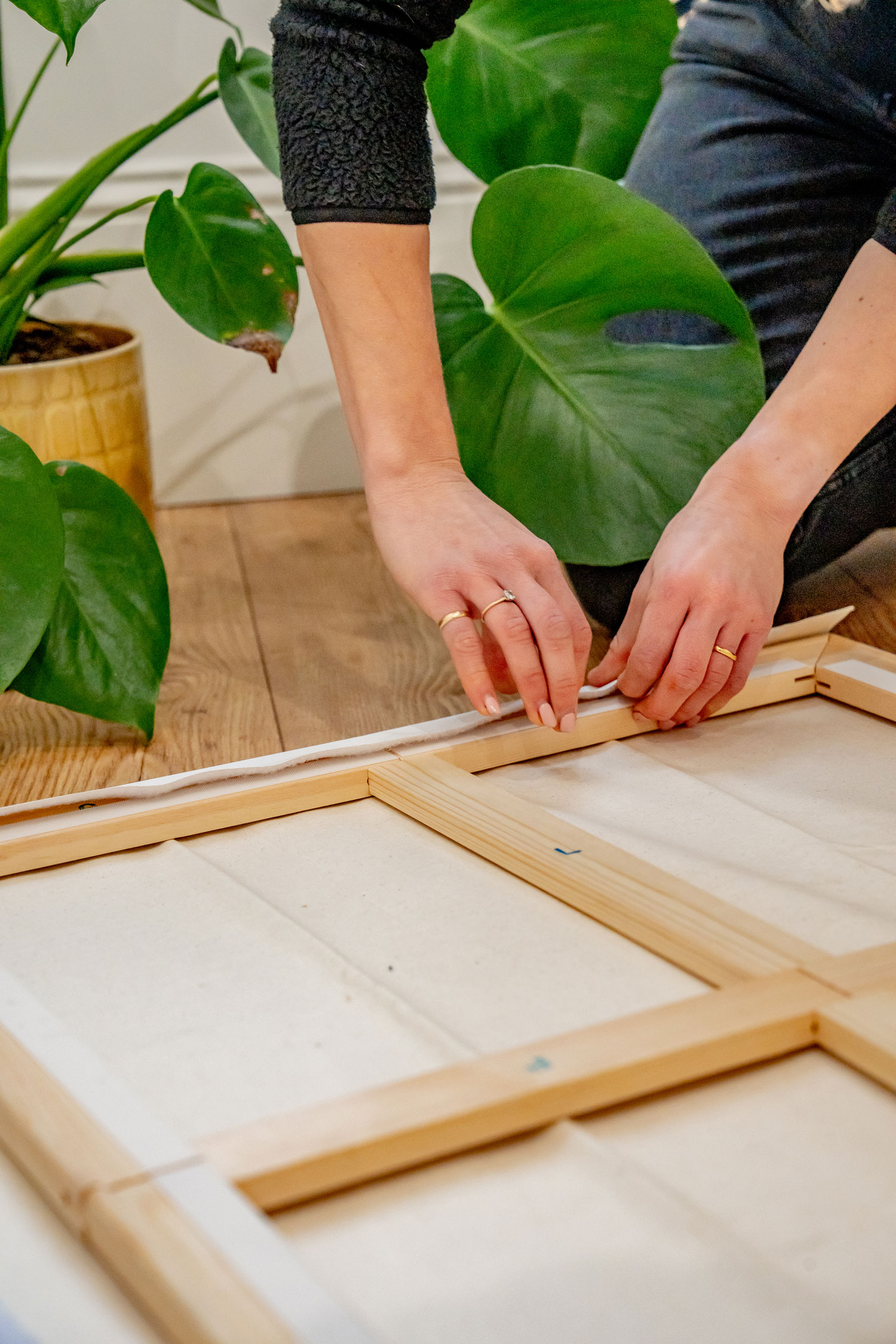
Once you’ve unboxed the kit and got to know your bearings, the canvas is super simple to stretch yourself – the wood slots together perfectly and the fabric is easy to stretch and manipulate. It’s extremely evident that the Sculpd product team have paid extra attention to the quality of this product. You’ll be seriously impressed with yourself (and Sculpd) by the end of it.
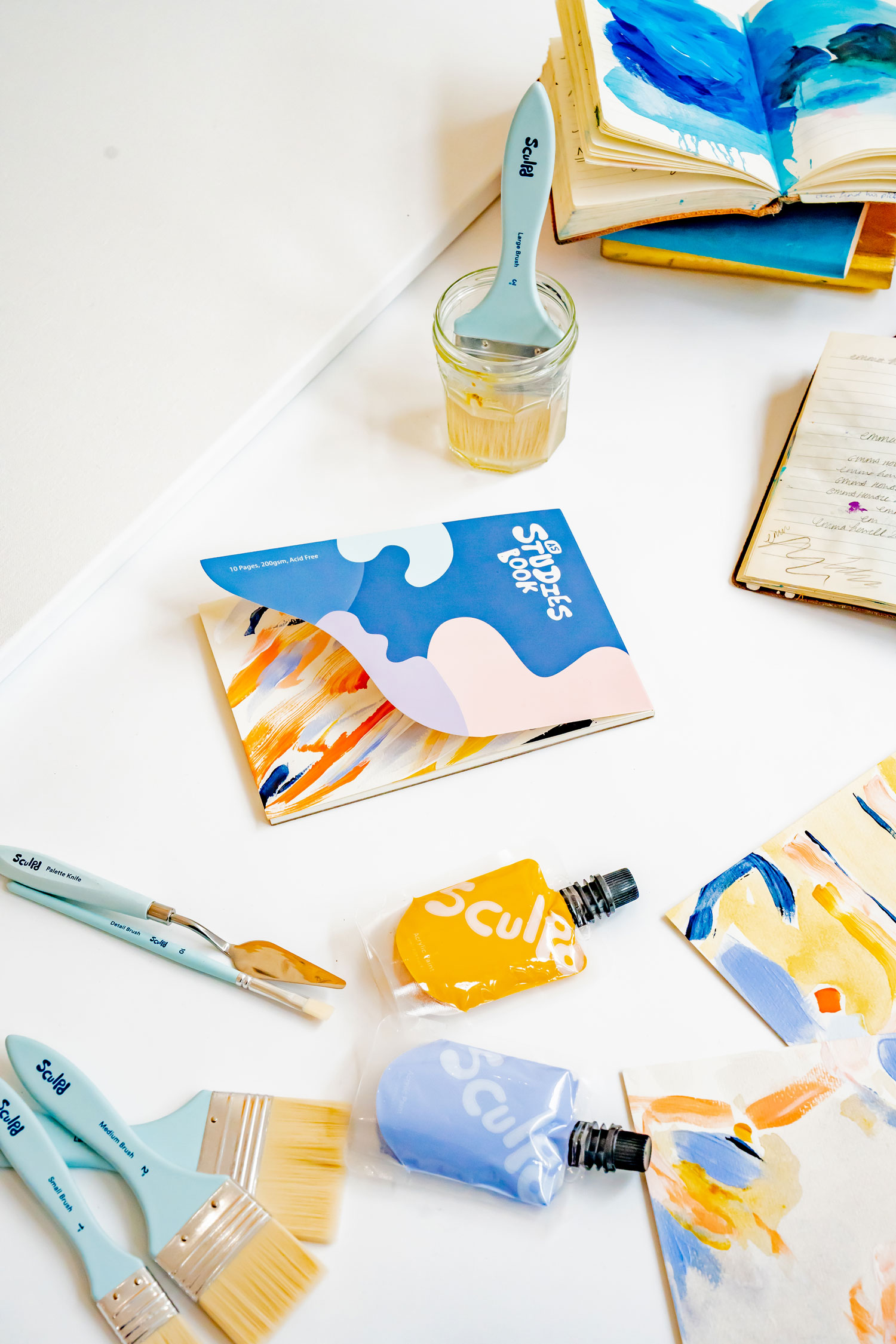
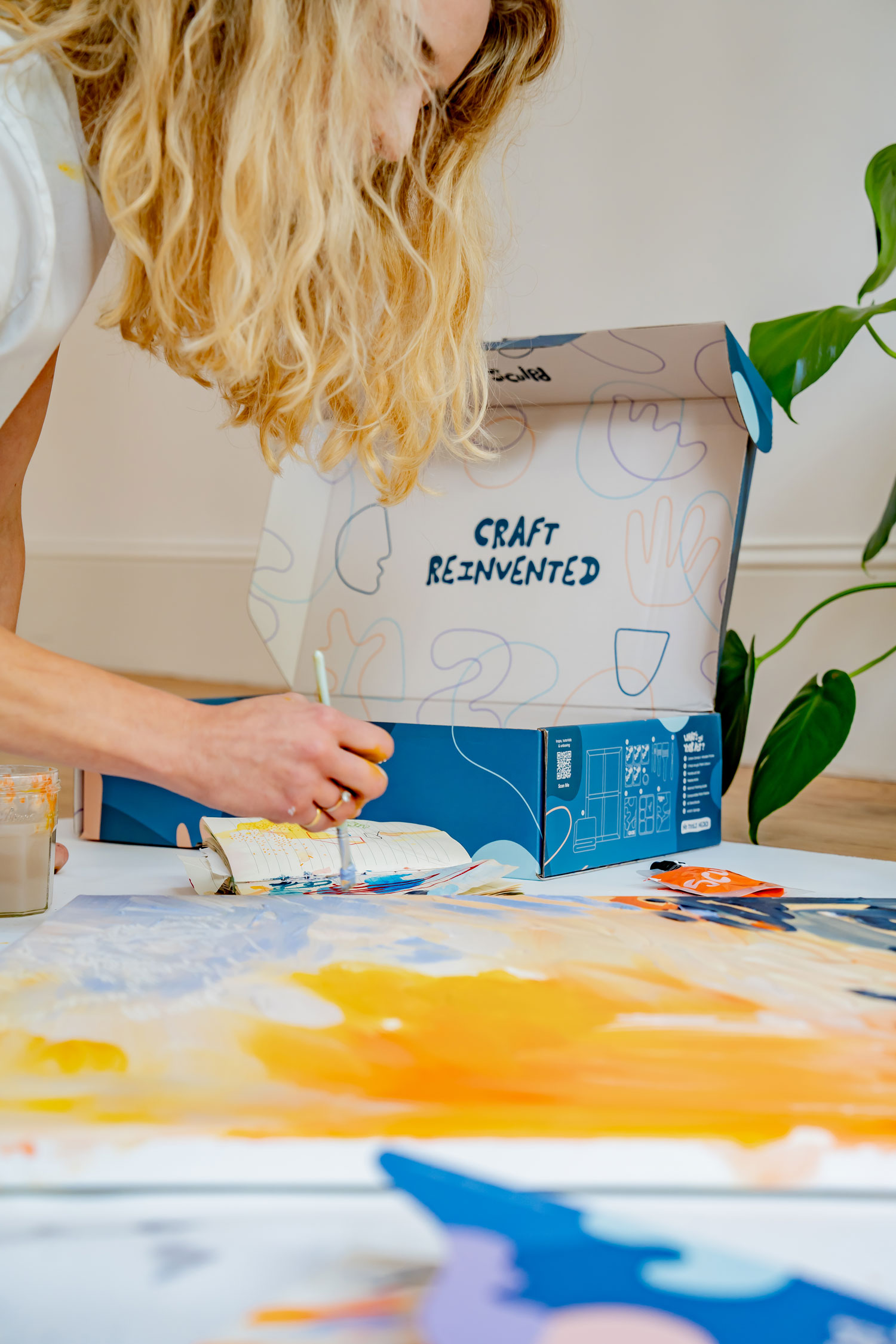
Time for painting – so, before I tackled the large canvas (60x80cm), I made sure to utilise the blank study book included in the kit. With this, it’s a good idea to get the hang of the paint (the colours, how it flows etc), let your hand feel the different tools, practice some mark-making and figure out what kind of composition you want to aim for. The guide included will also help with this – Sculpd developed it with a handful of abstract artists around the world, so we’ve all shared some top notch hints with you here!
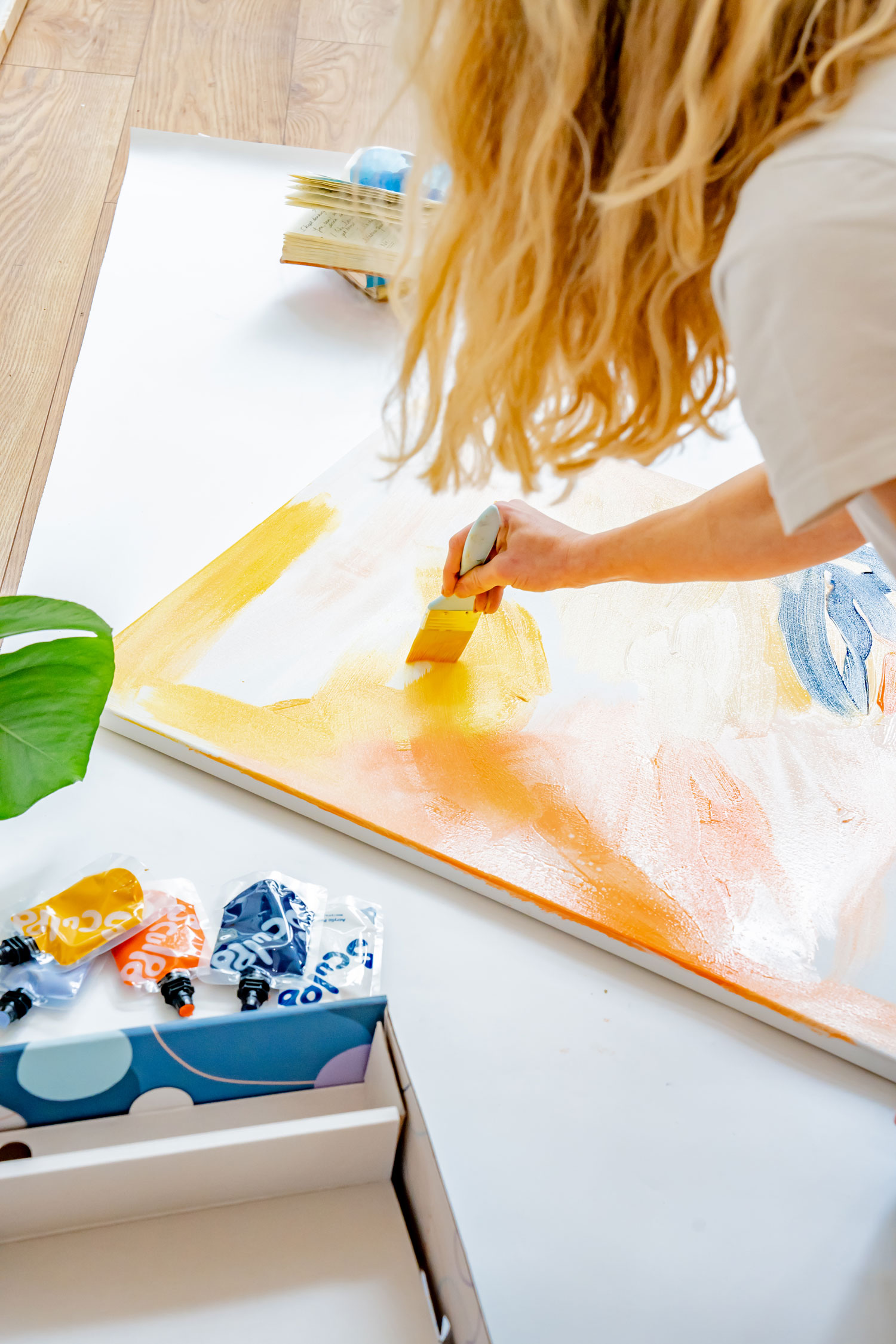
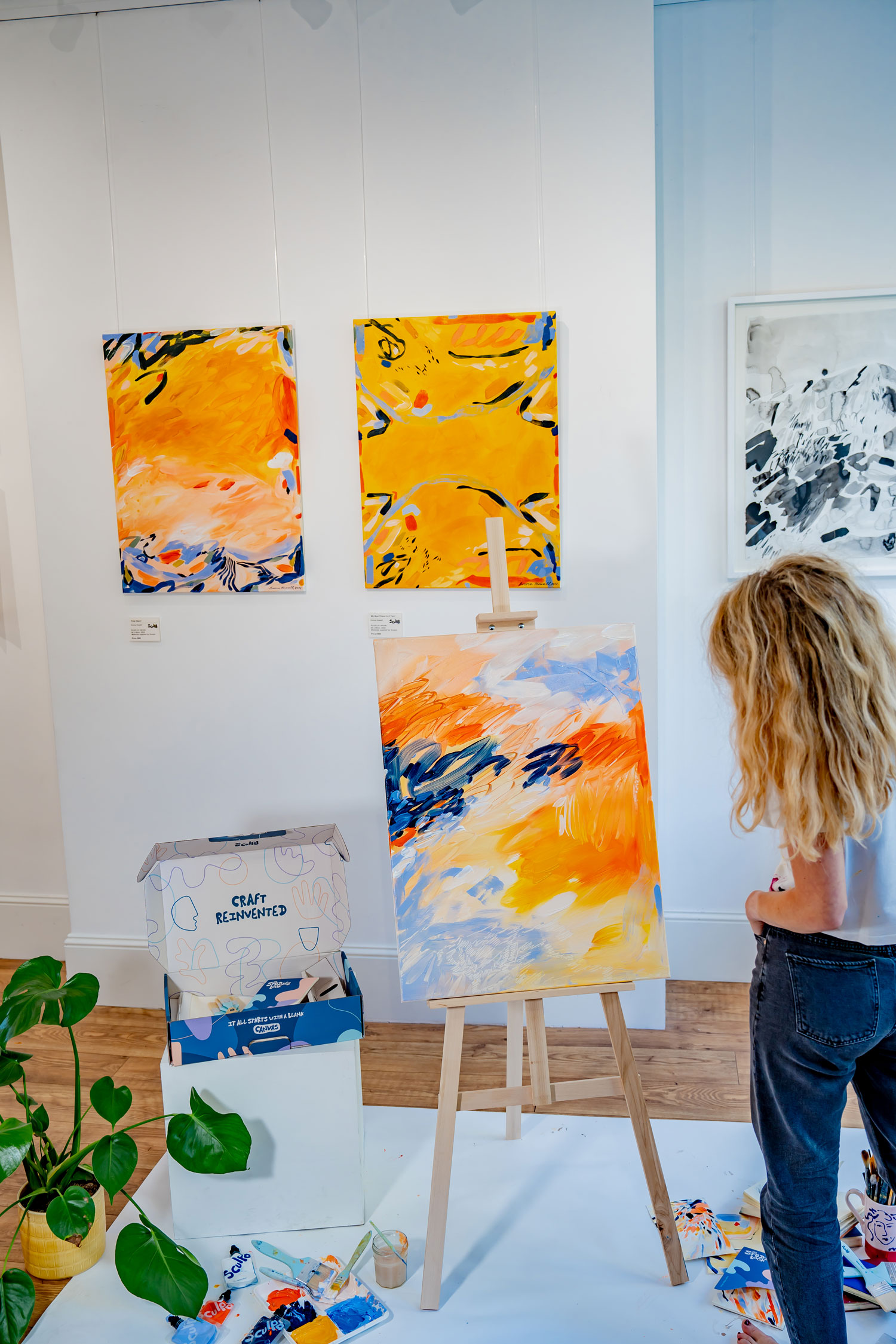
When you get to the final piece, remember you’re doing this for fun. Experiment, flip the orientation, throw paint around, step away from it for an hour, head over to Instagram for some inspiration, work from your studies.. There’s absolutely no pressure and zero rules here – do whatever feels right and trust your gut. You can paint.
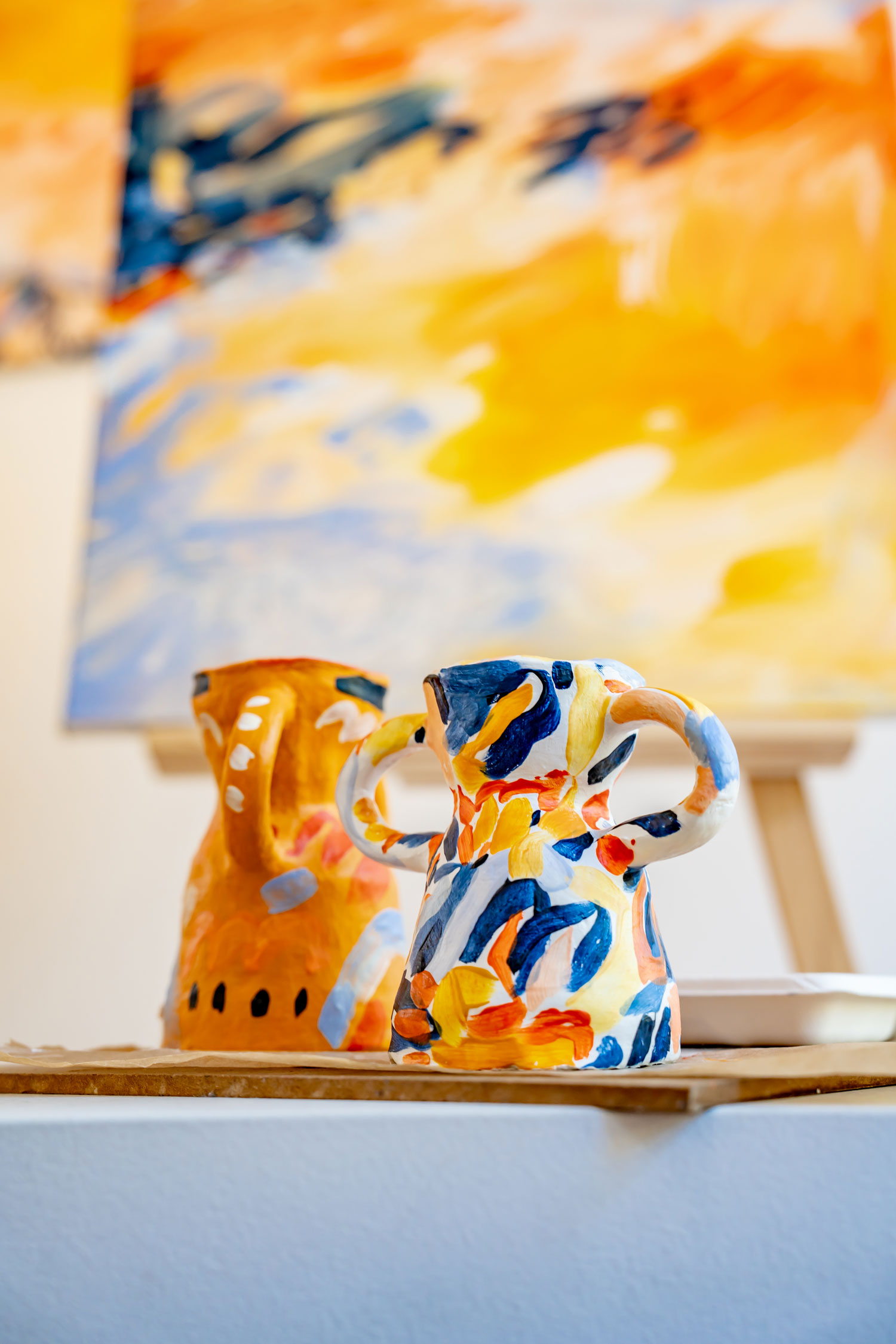
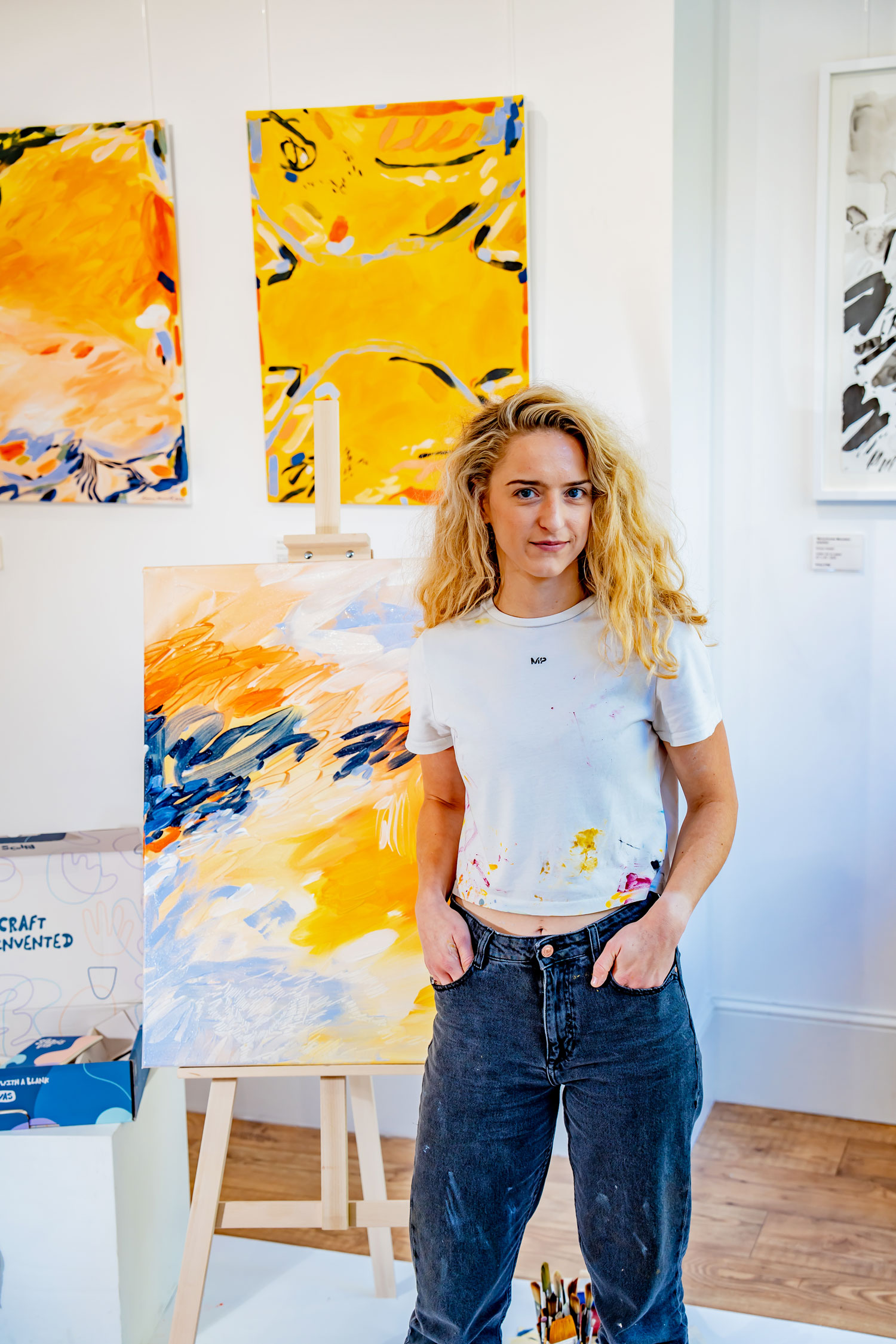
The three canvas pieces you see above were all made with the materials supplied by Sculpd, and you can totally do the same. It’s a great activity – mentally and physically. If you’re not quite brave enough yet, perhaps get a friend or family member to try it first for their Christmas present. 😉
FYI, the colour scheme I used was titled ‘bold’, but you have two others to choose from.
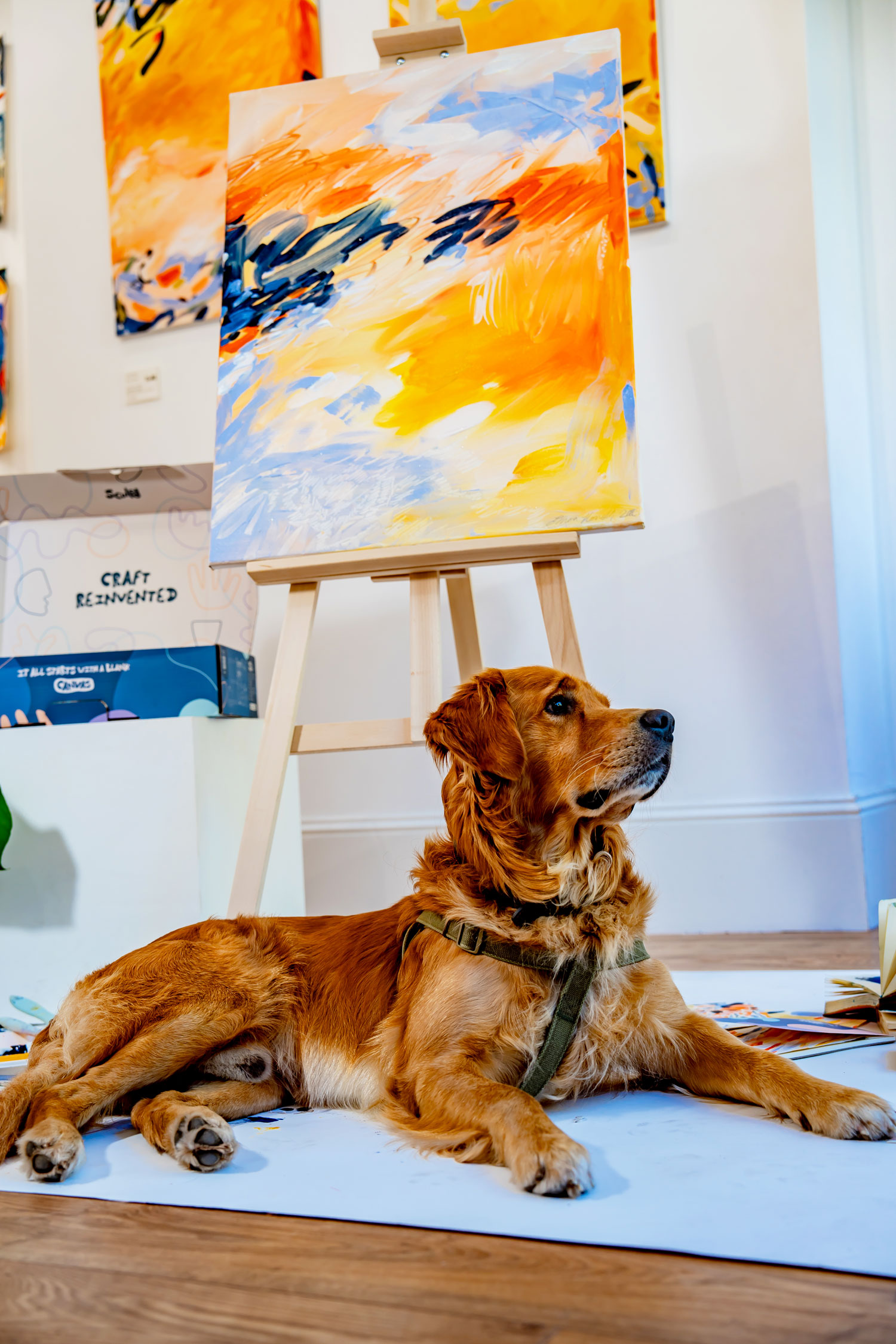
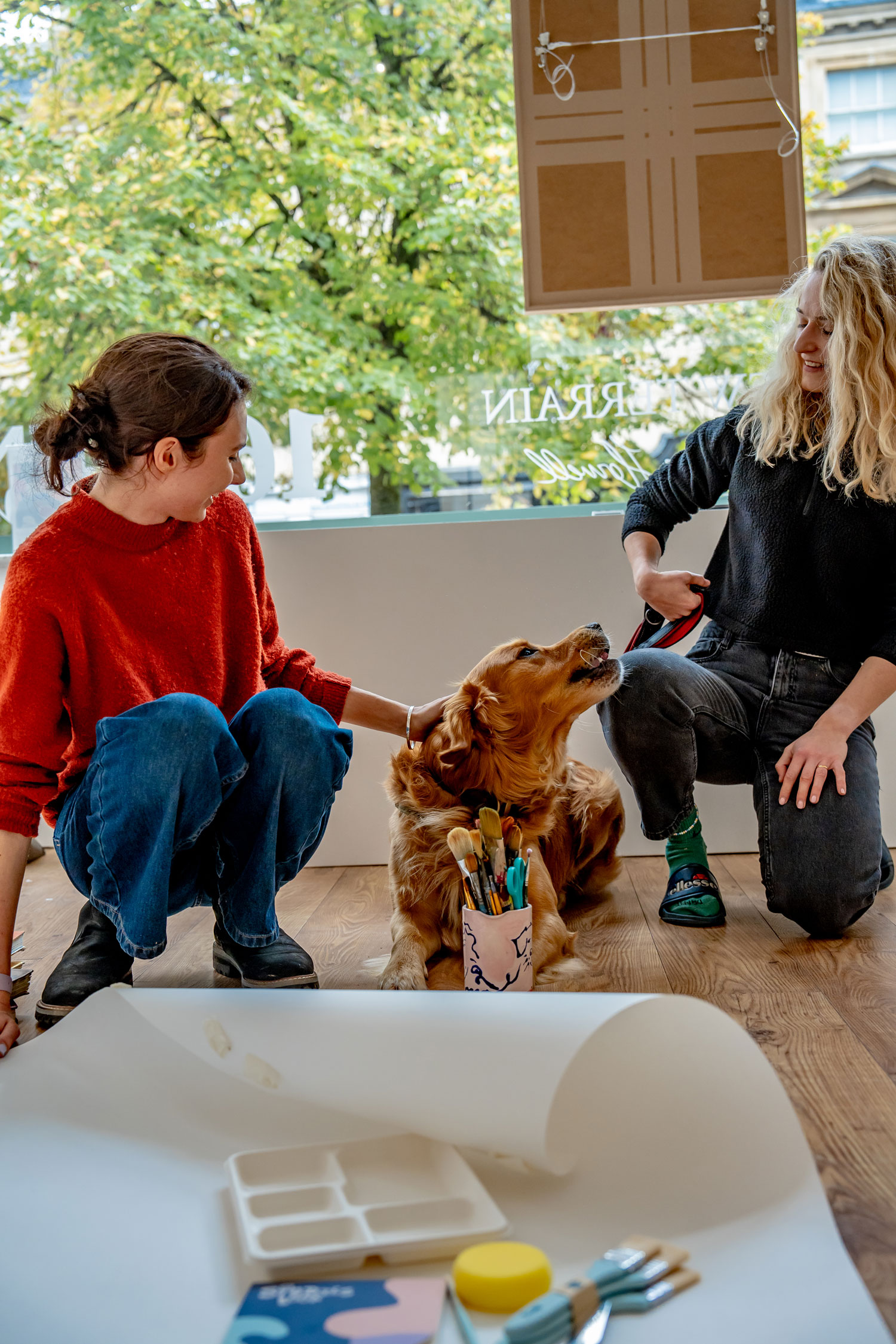
Oh, and obviously, Gibson met the team. He did his usual ‘crunch face’ at the crew (a.k.a showing them his teefs), but it’s just a hello and he (luckily for me) behaved himself. He even worked his way into some shots. Typical retriever: absolutely hogging the attention (that’s fine with me).
All images supplied by Sculpd (2022). This was a paid partnership. Huge thank you to the team for this incredible opportunity. Can’t wait for the world to start painting.
FAQs: Artist Life, Dogs and Shipping
August 28th, 2018 by Emma
Here are a few answers to the questions I was asked last week on Instagram:
What things do you do other than your art business?
In regards to work, besides painting and running my business, I work part-time in a marketing agency (very flexible, usually 2-3 days per week). Here, my work consists of searching the web for blogs, developing relationships with other businesses and writing emails. I won’t bore you with the details, but this type of work helps me develop my digital marketing skills for my own website.
Outside of work, I go to the gym 3-4 days a week to keep up with a powerlifting programme written by my trainer (and sister-in-law) Hannah Howell. At weekends, my boyfriend and I will try and make an effort to go on mini local adventures – usually hiking, cycling, walking or road-tripping (typically to places where I can sit and sketch/paint). If we don’t, duvet days do happen – or admittedly, I work on growing my business at weekends.
What is the hardest part about being an artist?
Ugh. I can’t name one thing. Despite what most non-art-focused individuals probably think, being an artist is really really really hard. It isn’t just slathering paint across a surface and getting people to buy it. Many do not realise how big the art career jigsaw is (e.g. networking, handling finances, generating leads, sending hundreds of “check out my work” emails, keeping up with social media marketing, sporadic income, artwork inventory, responding to emails, battling with self-doubt, photography, framing, spending all my money on supplies, rejection, rejection, generating new content, constant need to innovate, insomnia, rejection..). Not only is it big, it is also terribly difficult, and there are some moments when all I want to do is give up and throw it across the room. Seriously – despite my successes, I doubt my ability to continue the art career jigsaw weekly. No, that’s a lie – daily.
So, perhaps the hardest part about being an artist is maintaining the faith.
Another hard thing about it is having to walk this earth feeling very misunderstood. Let’s face it, there are so many people out there that have bad things to say about us who make paintings for money. Even in the gym the other day, I was telling someone what I do and they responded with: “That’s not a job?! Is it?!” – a fake smile and laugh moment, I must say. Abstract art, especially, is quite often not well received. But I’m kind of over this one – I think. Until I’m not. Admittedly, I sometimes feel that if I painted fantastically accurate paintings of horses or emotive landscapes, I’d have a much better time showing people my work.. but, I don’t enjoy that type of painting (at the moment, anyway).
Spreadsheets, finances and talking about myself isn’t that easy either.
What’s the best thing about being an artist?
Freedom.
How do you ship your artwork?
- Artwork that is framed with glass is carefully packaged and shipped with a local courier. Masking tape is applied to the glass in strips, so that if the glass breaks in transit, it will remain in place and won’t damage the artwork. Acid -free tissue paper and a layer of bubble wrap is folded and placed on top of the glass, then cardboard corners are fitted. The entire work is then wrapped in acid-free tissue paper and multiple layers of bubble wrap. Finally, the package is tightly wrapped and taped up in cardboard, so that the work cannot move around. I haven’t had a single breakage reported yet.
- Unframed paintings are wrapped in acid-free tissue paper, placed in a clear cellophane pouch and shipped in a firm envelope.
- Canvas work is typically removed from its stretchers and rolled in a tube. However, this method is being reconsidered for those who’d rather it be still on the frame.
- I ship worldwide and prices vary depending on the type of work and its destination. For larger works or framed works, your shipping cost will be invoiced to you separately.
- Local pick-up is available and occasionally, I can personally deliver works (in this instance, there will be a cost for the petrol and you’ll be invoiced separately).
Can you recommend any places to visit in the UK?
So, I can recommend a few places, but unfortunately I’m actually not that well travelled within the UK. However, this will be changing soon, as my next art projects involve exploring my homeland. There are many places I want to go, like Durdle Door, the Lake District, Pembrokeshire Coast, the White Cliffs of Dover.. to name a few.
Here are places I have been that I think you should visit:
- Cheltenham, Gloucestershire (my hometown) – particularly Cleeve Hill at dusk or dawn.
- Broadway, Worcestershire – go for a walk up to the tower then grab a pub lunch at The Lygon Arms.
- Pen y Fan, Powys, Wales – hike to the top, the views are incredible.
- Centre of Liverpool – like a mini London on a harbour, great places to eat/drink and super clean.
- Bath, Somerset – if I didn’t love my hometown so much, this would be my second choice of places to live in the UK. It’s colourful, friendly and has great markets.
- Canterbury, Kent – really lovely cathedral city, steeped in history.
- London – just because you have to go to there at some point in your life.
And a few more.
How do you juggle everything? (E.g. painting, your other job, hobbies, writing a blog)
I don’t. I am forever dropping the juggling balls.
But these help: spreadsheets, an 18 month diary/planner, a boyfriend who is a Web Developer, beer, a free PT sister-in-law, the mere sight of a dog, 9pm bedtimes and 6am wake ups. Just don’t waste time and get shit done – simple. Unless you want to binge watch Orange Is The New Black or Friends because that’s totally OK.
What piece of advice would you give to someone who has lost someone close to them?
I briefly touched on this in my interview with We Heart but I’ll reiterate:
It hurts, all the time. So, for anyone who is suffering with loss and stuck in the crossfire of grief, find an outlet. Particularly something creative (and positive), like painting, dancing, playing the guitar, writing or whatever; something that enables you to feel some sort of control over yourself. Because control is something that you may feel you’re lacking right now – I certainly did. A creative outlet also steers you away from other types of negative outlets (e.g. excess drinking, emotional bingeing, drugs and social isolation etc.).
Life didn’t make sense after my Dad passed away. How could someone be taken away from me just like that? It didn’t feel real, so my everyday started to feel like a hallucination. I can’t explain the feeling, but if you know, you know. I basically had to “find myself” again.
You’ve got to, somehow, redevelop yourself into someone that has to exist without the person you’ve lost. Perhaps think about what they would want you to do.. because they certainly wouldn’t want you going mad and crying all day.
Honestly, however hard this is to believe now, you will be a stronger and braver person because of this. Keep fighting.
What paints do you use?
A bit of a hard question to answer because I use a variety – depending on the surface I’m working on and also what I feel like using. Golden Fluid acrylics are my usual go-to, but I also use Montana Gold spray paint, Lukas Cryl Studio acrylics, Golden Heavy Flow acrylics and Winsor & Newton tubed watercolours.
What one piece of advice would you give to an artist JUST starting out?
Firstly, you may find this blog post useful.
One piece of advice I’d give to artists who are just starting out is: hunt down and ask for opportunities yourself because no one is looking for you. Harsh but true.
Also, get yourself a website and document, document, document.
Which is your favourite “How” painting?
There are a number I’ve warmed to. But the most I’d say is How #31, which is actually still available.
Are there any foods you hate?
Great question. Yes – I really just cant handle raw tomatoes. I’ve really tried – believe me. Cooked tomato and tomato in any other form is absolutely great. But if you give me a raw one, it won’t be well received.
Tell us about your dogs
(This is for my lovely artist friend, Heather.)
My family have two dogs:
Rambo (right), a highly intelligent 5 year old Golden Retriever X Labradoodle. He only accepts affection on his terms and likes to be on guard to make sure no squirrels and cats enter his garden. He’s also absolutely fascinated by balloons and is the ultimate fly catcher. Many people can’t quite understand how he’s part poodle, but if you study him well, you’ll see that he’s got quite a pointy nose and a tail that sticks up quite vertically, just like a poodle. Funnily enough, Rambo looks absolutely nothing like his full siblings, who are much smaller with curly poodle hair. He was a complete anomaly.
Willow (left), Rambo’s half-sister, an almost 2 year old Golden Retriever X Labrador. She definitely doesn’t share Rambo’s vocabulary, but she does try her best to copy his odd behaviours. She will only sleep in human beds, is mad for water guns and likes to sit upright with her legs wide open (very classy). If we buy them both toys, Willow will only accept the one that is in Rambo’s mouth. She’s not a very loyal dog, as she loves absolutely everyone – everyone except for children. She’s not aggressive, but she barks at them and we don’t know why.
Update: This is Gibson, our 8 month old dark golden retriever. He’s very very greedy, obsessed with carrots and absolutely wonderful.
What are your next plans?
I’ve got a few things in the pipeline at the moment:
I’m talking with various UK based universities about the prospects of being a guest lecturer, hoping to talk about life as an emerging artist and ways to get started. I’m working on another exciting painting project with Hobbycraft, which is likely to be shown in stores early next year. I’m planning some trips around the UK, on the hunt for new colours, marks and textures to document for my next series of paintings.
Paintings in Cheltenham: An Artist Exploring her Hometown
July 24th, 2018 by Emma
An artist, a photographer and a digital producer wandered the streets and the hills of Cheltenham to photograph new abstract paintings that debut this August.
Located on the edge of the Cotswolds, Cheltenham is a regency town renowned for its horse racing, cultural festivals and areas of outstanding natural beauty. I was born here, in this beautiful place – and I’ll never take for granted.
Many of the new paintings exhibiting in my first solo show, Homegrown, were inspired by Cheltenham and its surrounding areas – so, here are a few fitting in with the townscape.
Pen y Fan, 22″ x 15″, 2018. Queens Hotel.
Pen y Fan, 22″ x 15″, 2018. Cheltenham Promenade.
Listen To Winter #2, 22″ x 15″, 2018. Next to Sophie Ryder‘s The Hare and the Minotaur.
Pen y Fan, 22″ x 15″, 2018. The Beer Gardens.
Listen To Winter #2, 22″ x 15″, 2018. Pitville Pump Rooms.
Never Far From Colour #2, 22″ x 15″, 2018. Cleeve Hill.
Please join me at the opening of my show on Friday 3rd August from 7pm until 10pm above Aroundabout Sound on the lower high street, GL50 3JA.
View all the paintings exhibited.
Follow my practice on Instagram.
Photography by Matt Beard.
Frames by Regency Gallery and Framing.
Paintings by Emma Howell.
What to do after your Fine Art Degree
July 6th, 2018 by Emma
First things first, being a fine artist is hard.
So, if you’ve just graduated in Fine Art, this post will hopefully guide you in the right direction and help you decide what to do after your Fine Art degree.
So, your degree is finally over
You’re feeling really good. All of the work is finally over. Your dissertation is in, your degree show has come to a close and perhaps you’ve even sold an artwork or two as well. It’s a great feeling of accomplishment – I remember it well.
So, what do you want to do now? Perhaps give yourself a break and go on holiday – or swiftly throw your CV out here, there and everywhere to start earning some money in the “real” world. It’s a pretty tough time, despite the celebrations.
My transition from graduating to working as an artist was not smooth, at all. I completed university at the end of 2015 and got back into painting at the beginning of 2017. That’s a pretty big gap.
To be honest – when I graduated, I wanted to escape Fine Art. However, I did make an effort to research potential jobs, like a gallery intern, a school art technician or an artist’s assistant – but found myself feeling nauseous about the whole notion of “The Art World”. It didn’t feel very me (at the time). So, in the two-ish year gap, I bounced from role to role, trying to figure out what I wanted to do. I worked in a clothes store, behind a bar, at a school and in a nutrition centre – but nothing brought me happiness. Unfortunately, I had to suffer a tragedy to realise that working as an artist was, in fact, what I was meant to do from the start.
Looking back, I only wish that I’d found a blog post about what to do after a Fine Art degree – it would have made it a lot easier to make a decision.
So, what should you do now? Keep reading.
Like I said, “The Art World” is pretty intimidating
You’ve got to accept this. The Art World is a huge industry and it’s very competitive, often pretentious and all-in-all a scary place to be. You’ll know from your course that putting your artwork in front of the world is quite frightening – so are you ready to take on the challenge of trying to make money this way?
There are thousands and thousands of artists in the UK trying to make it – and most likely in all the other countries too. The market is overcrowded, but does this mean you shouldn’t bother? Absolutely not.
You can fit into the Art World in whatever way you want to – just don’t expect Charles Saatchi to chase you at the start of your career.
Well.. you never know.
Let’s be frank: you need to get (another) job
You know the whole ‘starving artist’ notion? Well, it’s damn true for the majority of us. We are poor and busy, so we have to sacrifice a lot of things (our social life, holidays, relationships, clothes, stuff..) in order to stick to our plan of being a full time artist – it sucks.
Quality art supplies are also extremely expensive. And when you’re adding this cost to your studio rent, house rent, bills etc. your outgoings are getting pretty hefty.
So, when you’re a recent graduate – unless you’ve made killer connections, have a financial aid or already have an ace reputation – it’s going to be very hard to fund your whole art business on art sales alone.
Don’t put all your eggs in one basket. Go get a regular job – for the time being.
Having another job also gives you more social interaction and an opportunity to step back from your work once in a while. So, try not to feel bogged down by a bar job, office work or making coffee because it’s only temporary.
But what’s it like working for yourself?
Do you like working for someone else? Or do you dream of being self-employed?
I’ll tell you now – working for yourself (particularly as an artist) is risky, terrifying and unpredictable; some people may call you mad, stupid and/or reckless. But do you know what I say to these people?
I say “yeah, you’re right – and look how much freedom I’ve got”.
Freedom.
Working for yourself grants you omission from a crowded office, an intimidating boss and the requirement to wear smart clothes. Working for yourself means that you have no choice but to grow into a strong, independent and business-savvy person – no choice.
Which brings up a slightly negative aspect of self-employment: for someone who isn’t blessed with the gift of mathematics, who lacks organisational skills and a self-esteem (me), it’s very hard to get the hang of taxes, marketing and self-promotion.
You feel out of your comfort zone 24/7.
But isn’t that marvellous?
What better way to learn how to swim than to constantly be in the deep end.
Hold up. What about an MA?
This is a tricky one – and it all depends on you and your lifestyle.
I was urged by my course leader to do an MA in Fine Art. My first thought was absolutely not – can I have a break from education please?
However, last year, the prospect of going back to study art at a higher level (and at a more prestigious art school) seemed rather appealing. I’d followed a few art schools on Instagram, and found myself craving the routine and academic/social aspects of university life. So, whilst I was on the plane home from Greece, I wrote pages upon pages listing the pros and cons of studying an MA.
Here are some points I deduced:
Pros
- Relevant networking/making connections
- High end galleries may favour your CV
- Potential to learn more (first-hand) from academics
- You get a studio space (hopefully)
- Interaction and collaboration with other artists
Cons
- It’s very expensive – do you want to be in more debt?
- It does not guarantee success – by any means. In this day in age, more and more artists with no qualifications are being considered by galleries and businesses.
- It will take up more of your precious time
- You’re location dependent – again
When I returned to Cheltenham, I sat on the floor of my studio and looked around at what I’d already achieved (without an MA) – and at that very moment, I decided to not go through with it.
My student loan is already over £30k and to be honest, I don’t feel like I need an MA. I have faith that I’ll be successful without the letters after my name.
But, please – if you want to go for it, go for it; It will be an incredible experience, regardless!
Finding a studio space
So, if you’ve decided to hold off on the MA for the time being, it’s time to find yourself a place to develop your art practice.
One common notion among local artists I’ve spoken to is that finding a space to create your work can be a very frustrating and expensive ordeal. At the beginning of your art career, your space to work in is likely not going to be glamorous.
Do you have a spare room? Do your parents? Perhaps there’s a local space for emerging artists in your hometown? I’ve seen some artists working in garages and heard about some who rent desks in an office – yes a desk in an office. Unfortunately, at this stage in your career – you need to find wherever you can to do your work.
I don’t advise that you use your living room or bedroom – this is what I did for the first 6 months. I found it claustrophobic and felt as though I couldn’t take a step back from my work; I was constantly immersed in it, which isn’t always good.
As an example, imagine being stuck in a room with one person – day in day out. You do like that person, but there are moments where you just need to walk away for some air, some space, some perspective.
Having your artwork spread out in front of you, alongside all of the paints, brushes and materials can also get pretty cluttered – so, not ideal for a living space. You’ve also got to be respectful towards your housemate, if you have one. Sorry for the messes I used to make, Jon.
My studio situation is both unfortunate and fortunate. At the beginning of 2017, I moved into my studio (and now gallery space), which sits above my Dad’s music shop. It’s quite a large room with a 12ft ceiling, old wooden floors, plenty of wall space and a large window that looks out to Cheltenham’s busy lower high street. In a lot of ways, this space could be considered an artist’s ideal studio space – and I’m very grateful for that.
However, the only reason I’ve moved there is because the room was cleared out after my Dad passed away in 2016. It used to be a stockroom and bass showroom for the music shop – but since my Mum took the reigns, she’s cut down the amount of stock in the building. Thus, leaving a lovely room – steeped in history – empty. And that’s why I moved in.
As American author Rick Riordan says, “out of every tragedy, comes new strength” and losing my Dad was where I found the strength to pursue a career as an artist.
Back to you – is your work crap?
Yes, you’ve completed a 3 maybe 4 year degree in art and you may be totally confident with your current style. But have a look around, what is the art world looking like. Be smart with yourself – are you making crap art?
If you intend to sell your work, you not only need to be really confident about it, but also you need to be realistic about a target market. Is there a particular market you want to sell to? Do you want to have gallery representation? Where do you want your work to hang – in hotels, in coffee shops, in people’s houses? Being focused on your work goals makes business a lot easier.
Of course – you are entitled to make whatever art you want to (I certainly do) and you could be just as successful as someone who’s planned it all out. But in this ever-expanding community of artists, does your work stand out – and is it good enough?
To figure this out, it’s important to know yourself and your work. So, grab a notebook and jot it all out.
Many, many times I’ve written down (and answered) these questions:
Why are you an artist?
What are you trying to show/prove?
Why is your work important?
Why should someone care about/collect your work?
Why do you use these particular materials?
Answering these questions keeps your head (mostly) clear, enables you to set goals and then learn how to reach them. If you have a scatterbrain like me (apparently quite common among creatives), you’ll need to regularly tune in with yourself. If you keep asking yourself why and how, I’ve found that it prevents those ‘what am I doing with my life!?’ and ‘my work is a load of crap’ moments.
Keep a level head and be realistic with yourself.
OK – and how do you make money as an emerging artist?
At present day, artists are being given more and more opportunities to make money – and not just by selling artwork. This is obviously the numero uno goal – make work, exhibit work, sell work, repeat. However, if you contact/are spotted by the right people/brands – and provided the collaboration would be ethically sound – you’re able to earn money through sponsored posts and targeted marketing campaigns.
Be smart and savvy with your art business. What are your skills other than creating artwork? Could you also teach and provide online content, like video tutorials and ebooks?
.. and that’s just the digital world.
What about the real world? Where you can host local workshops, set up market stalls and talk to real people about who you are and why what you do is important. Make friends. Make connections. Make business. Make money. (More on this in the next section)
So, how do you get ‘known’ or ‘spotted’?
This is tricky and it varies from person to person.
To get spotted, you need to put yourself out there – locally, regionally, nationally and internationally (usually in that order). Aside from social media, you need to network with the right people, in person.
‘To get spotted’ is actually something you shouldn’t rely on. From my experience, the best thing for you to do as an emerging artist is to ask for opportunities, and don’t wait for people to come to you because 9 times out of 10, they won’t – sorry for the bad news.
Ask for advice from other artists.
Ask a business if they’d like to see your work.
Ask a brand if they’d be willing to collaborate.
Ask an influencer on social media to share your work with their audience.
Ask your audience what they think of your latest piece.
It may take 100 asks to get 1 yes, but this is a lot more productive than waiting for people to find you.
But make sure you’re super confident in what you’ve created before you go out and ask – otherwise you won’t be confident to ask people. Once you’ve grown your confidence, find people and tell them who you are and why they need your work in their life.
In addition to this, an online audience is extremely helpful for exposure. Yes, I’m talking about Instagram followers, Facebook fans etc. It’s apparently meant to be the time for artists to get on the Instagram train. It’s very quickly zooming by, so throw yourself on – if you can.
Regularly publishing your artwork on social media (Instagram, Facebook, Twitter, Pinterest etc.) is a way to get more eyes on your work – and this is what you need. More eyes.
More eyes = more opportunities.
There are over 800 million active monthly users on Instagram. So, if you manage to ace the right kind of strategy, there is a lot of potential to grow your business here. It might be worth setting up a Facebook business page too.
You’ll be able to read how to promote your art on Instagram soon on my blog.
Hey – what about artist residencies?
An artist residency is a great option for young artists and recent graduates.
But what exactly is an artist residency?
They are programmes that give artists the opportunity to stay and make art in a place that is outside their typical working environment, away from their usual hustle and bustle. They give you the chance to develop your practice in a new location, potentially with new materials and quite often, among other creatives (and mentors). Bear in mind that many residency programmes come at a cost – and quite a hefty one at that. Conversely, there are paid opportunities too – you’ve just got to find the right one for you. Whether it be at your old school, in your capital city or on the other side of the globe in Bali, there are thousands of places you can dwell and develop your practice.
Residencies look pretty good on your CV too, so perhaps consider applying for a few when you’re ready.
Artsy have a great guide on how to go about artist residencies.
Get a website and start a blog
Seriously – do this now.
You need to get writing about your work, your influences, your inspirations – anything. You need an online presence that isn’t owned by a third party, like Instagram. Imagine if they got hacked or stopped completely, like Vine did (I loved Vine – anyone else?!).
You need to own your own online space where you can market yourself. Save up and pay for a website, or sign up to a free blogging platform. Do what you can to obtain a place to direct people, so that they can learn more about your work.
As well as being an artist, I also work in an SEO agency to help fund my practice. Here, I’ve learned a lot about the importance of a website for a business – especially in this day in age.
Write often and write well. You want people to find you – and Google love regular and unique content. No copy and pasting – you’ll get found out and it penalises your ranking on Google.
Once you’ve set up your website/blog, you’ve given yourself a huge marketing opportunity. And now, all you need to work out is how to get people to your website. Again, a very difficult task.
In addition to this, you could also consider setting up an online shop on platforms like Etsy or Shopify. You want to sell artwork – right? So, this is a great way to get started. But bear in mind that you won’t get many sales without a marketing strategy – yes, that word again. So, try and not waste your time..
To be able to market yourself, you’ve got to believe in yourself
Remember what I said earlier about confidence, marketing and self-promotion?
Well, to succeed as an artist, you must be able to talk about yourself and your work – confidently and regularly. If you don’t believe in your work, your talents – yourself – you cannot expect anyone else to believe in you. There’s a quote somewhere for this..
Most of us are self-critical and our own worst enemies when it comes to career/life goals. You know, that voice in your head that’s like “you can’t do this”, “your artwork sucks”, “you’re so out of your depth” and “this will take you years – don’t bother”. If you’ve ever said any of these to yourself, you need to go back to square one and ask yourself those questions I asked earlier.
When it’s time to start marketing yourself as an artist, you’ve got to make sure that you’re ready to talk about your work confidently and also, be open to criticism. Yes, there will be people out there that will hate your artwork. But that’s fine – because this means that there are people out there that will love your artwork.
Land your first “real world” exhibition
Set this as a goal and work towards it.
You may feel that this is well out of your reach right now – and hey, it probably is. But for you to make it in this world as an artist, people need to see your work. So, to begin with – go local. Ask local coffee shops, restaurants, offices, even art galleries how they’d feel about exhibiting your work. Tell them that you’re an emerging artist and looking for opportunities to increase your visibility. You’ll get a handful of no’s but remember what I said earlier, it may take 100 asks to get 1 yes.
Get the ball rolling. Once your work hangs in one place, it will start a chain reaction and create more opportunities (e.g. commissions, artwork sales and further exhibitions).
Generate local buzz, tell the press your story and promote the hell out of your work. Share it online and ask your friends, family and colleagues to spread the word. After a while, people will start talking about you and BAM you’ve got local exposure.
After you’ve had your first exhibition, whack it on your CV and then repeat the process. Perhaps go a little bigger next time and approach galleries/businesses in a neighbouring city.
Over time, your reputation will grow. But remember – this will all take time, so be thankful for your other part-time job at this point.
It’s all about the long game.
What to do after your Fine Art degree checklist
- Take a break but don’t lose momentum
- Decide whether or not to do an MA
- Get a part-time job (seriously)
- Find a space to work
- Develop your practice and be honest with yourself
- Consider an artist residency
- Introduce yourself online (social media and your website)
- Introduce yourself offline (talk to real people and attend events)
- Ask for opportunities
- Write regular essays/blog posts on your practice
- Develop and ace your marketing strategy
- Land your first show
- Network, network, network
- Repeat
So, do you still want to be an artist?
You’ve done so well to get where you are now; you should be proud of yourself.
Now, are you ready to climb the first rung of the ladder to be a full time artist?
Or is it all a bit too risky?
Up to you.
If you’d like to talk to me about this post, please do get in touch and I will respond as soon as I can.

